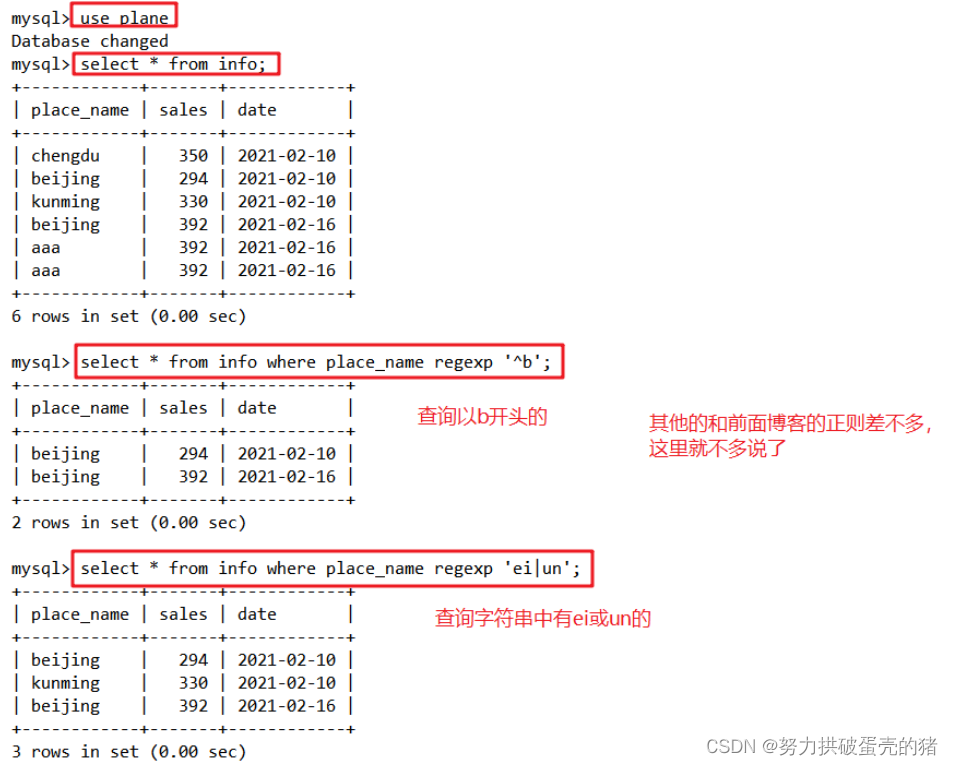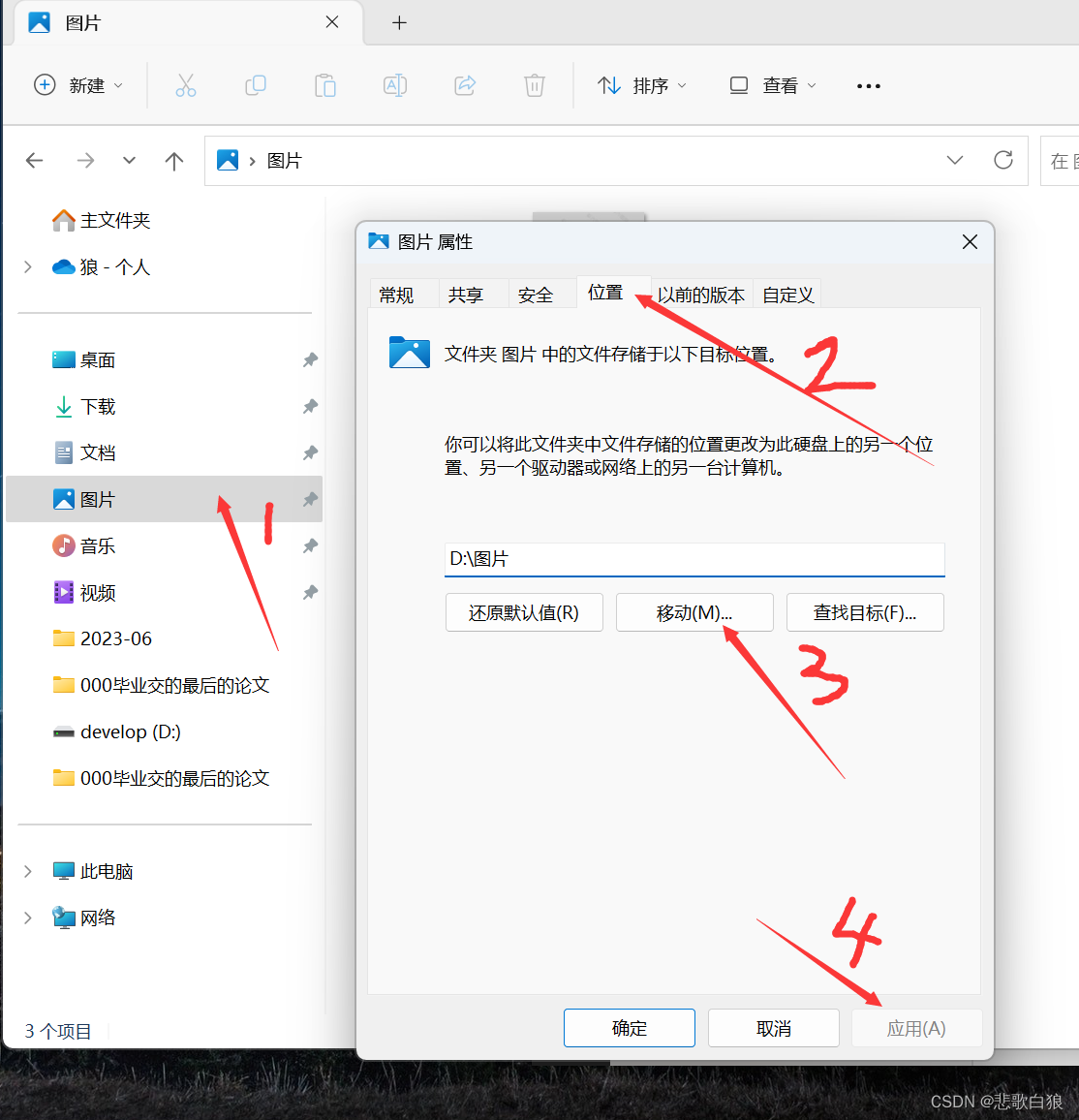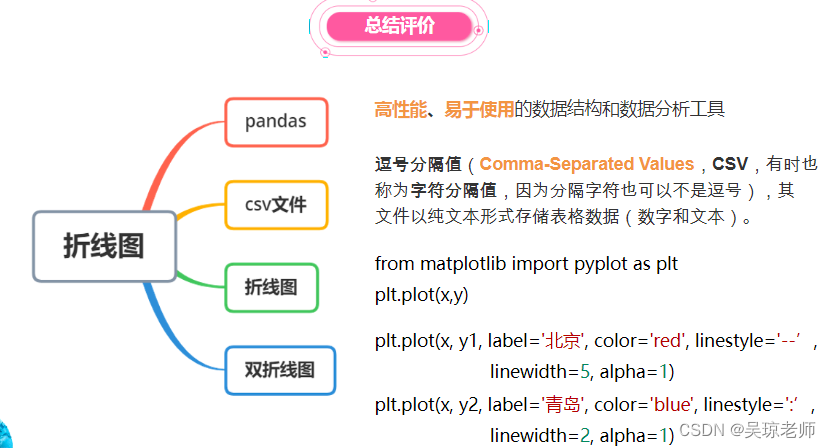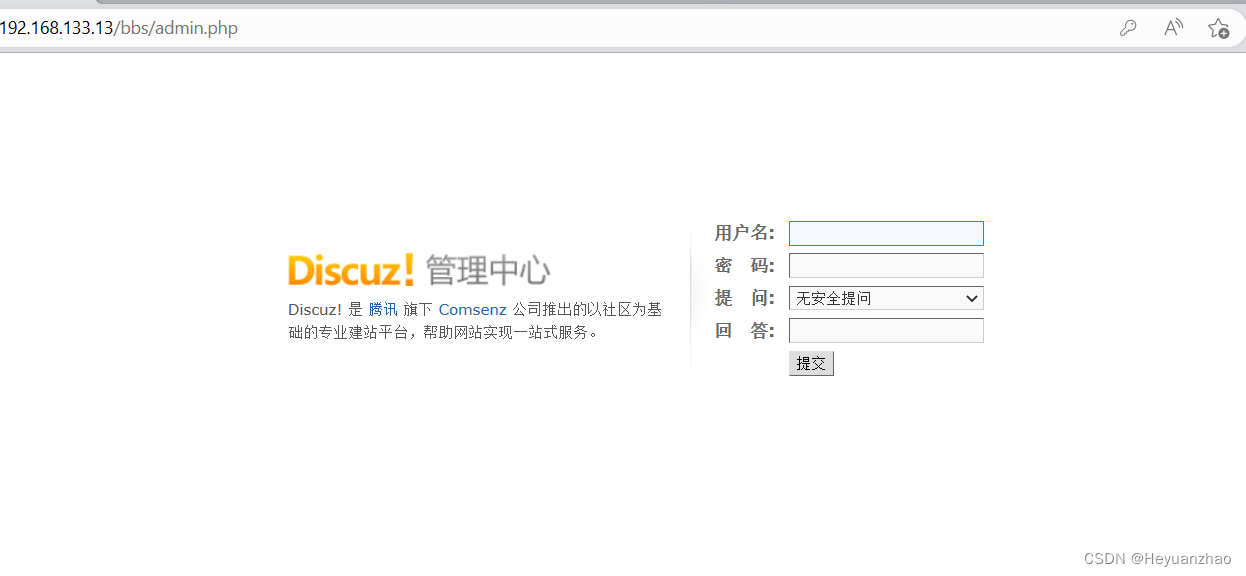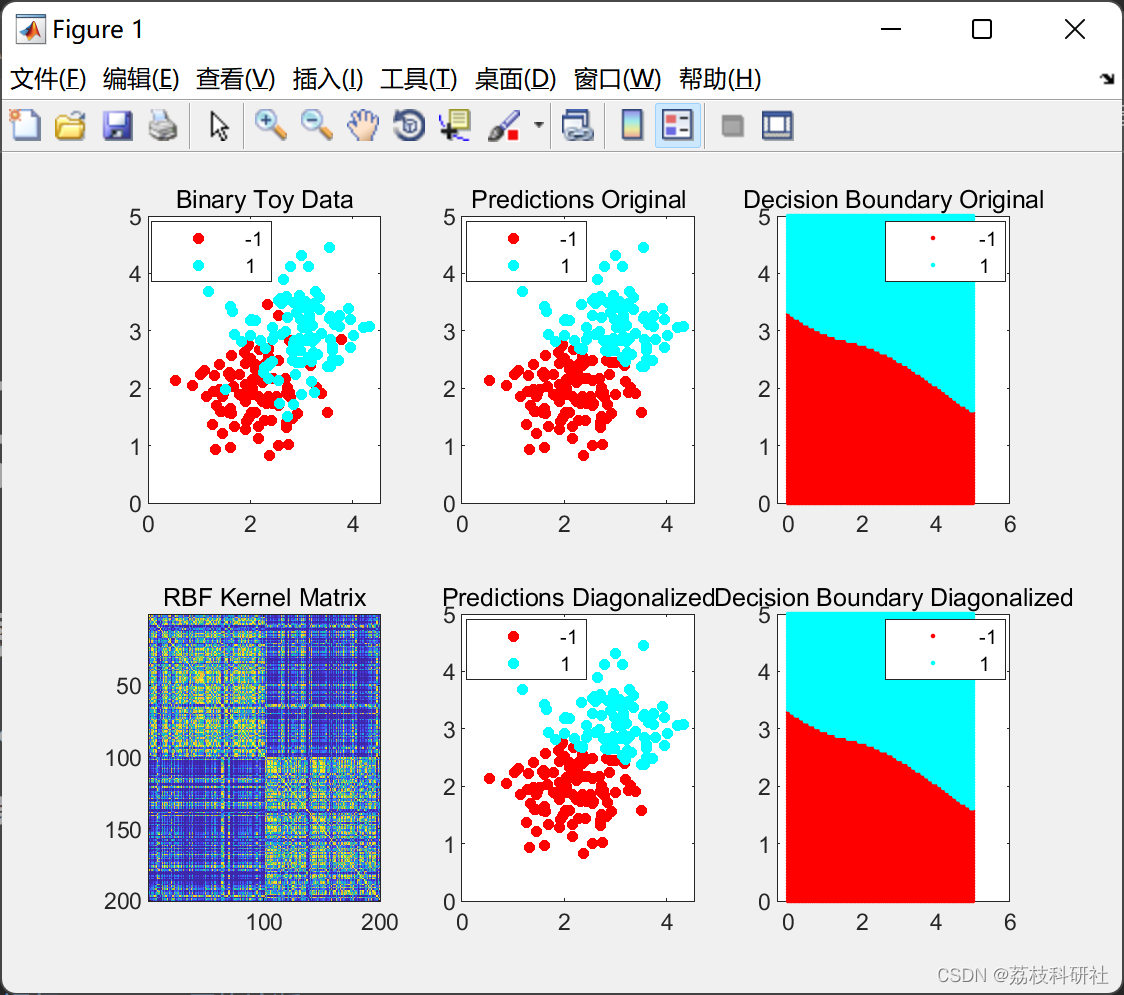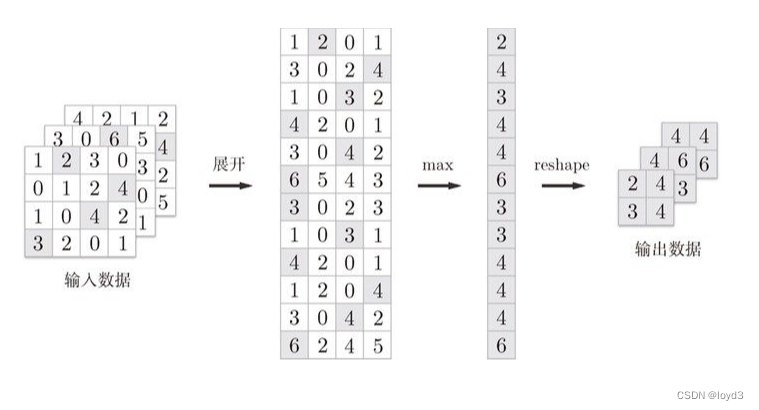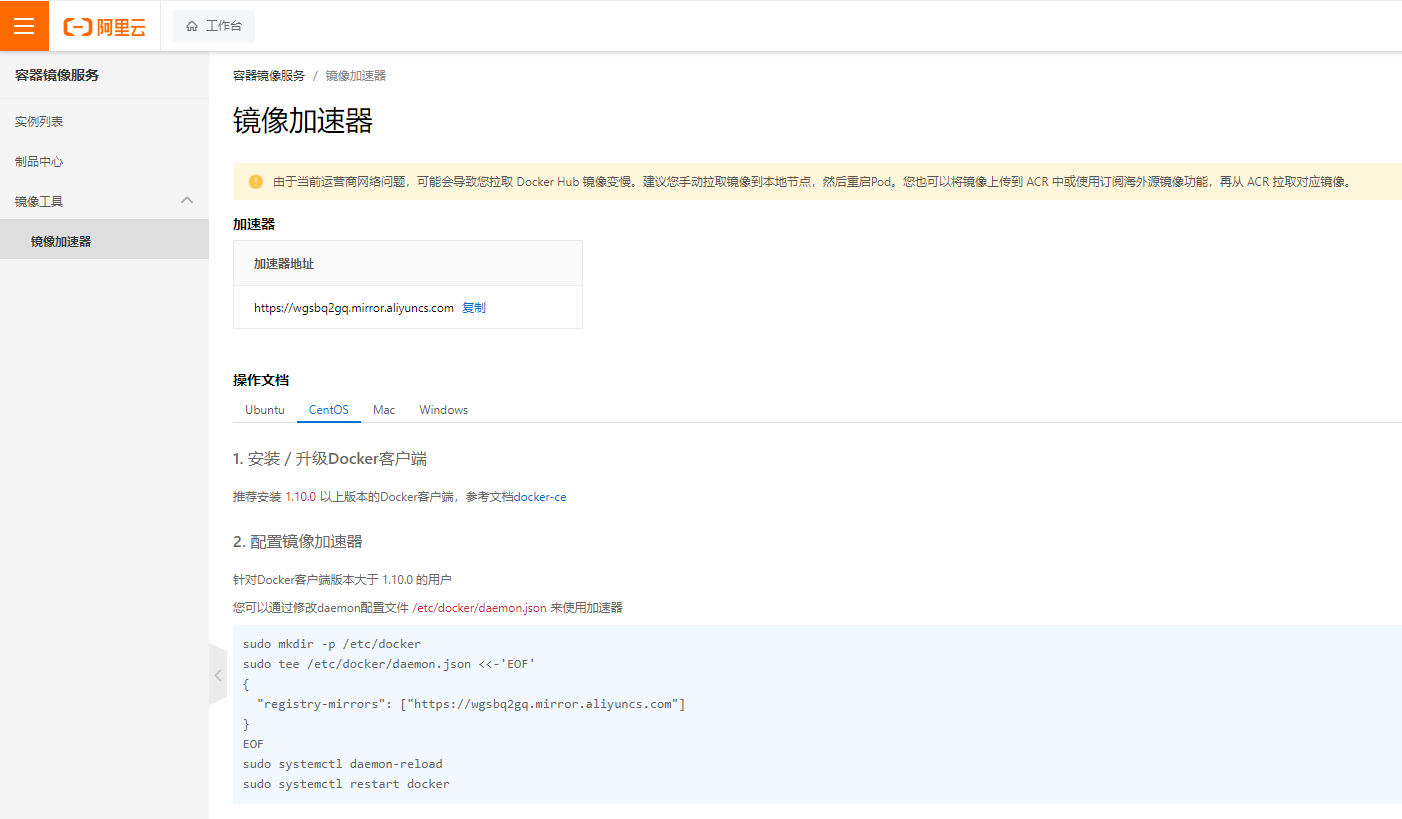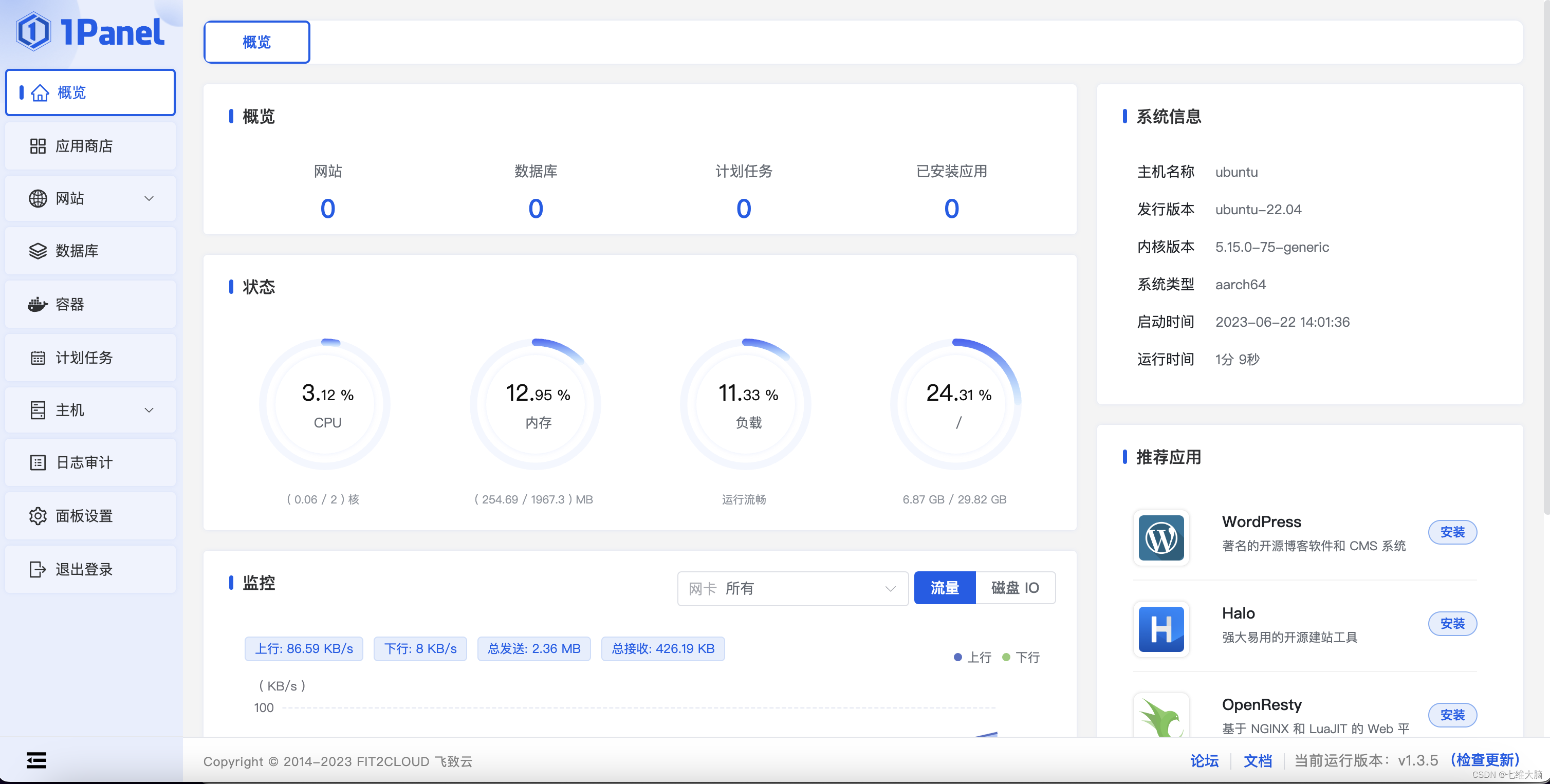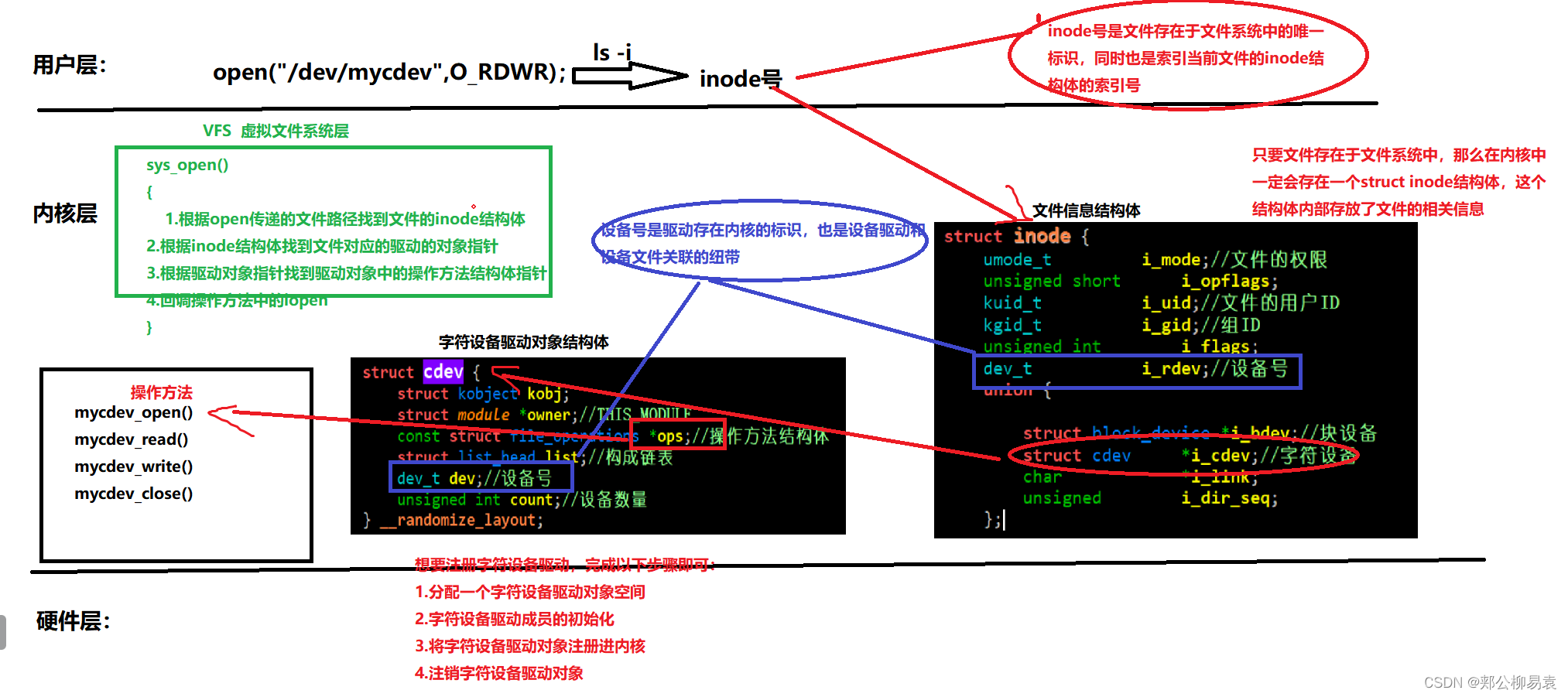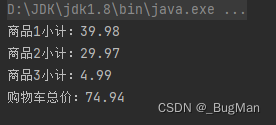一、MySQL高级语句
1.SELECT
2.DISTINST
3.WHERE
4.AND|OR
5.IN
6.BETWEEN
7.通配符
8.LIKE
9.ORDER BY
10.函数
(1)数学函数
(2)聚合函数
(3)字符串函数
11.GROUP BY
12.HAVING
13.别名
14.子查询
15.EXISTS
二:连接查询
1、inner join(等值相连)
2、left join(左联接)
3、right join(右联接)
三、CREATE VIEW 视图
四、MySQL之联集、交集值、无交集值、case
1、联集
(1)UNION
(2)UNION ALL
2、交集值
(1)取两个SQL语句结果的交集
(2)两表没用重复的行,并且确实有交集的时候用
(3)取两个SQL语句结果的交集,且没有重复
3、无交集值
4、CASE
五、排序
1、算排名
2、算中位数
3、算累积总计
4、算总合百分比
5、算累积总合百分比
(1)用累积总计 SUM(a2.Sales) 除以总合来求出每一行的累积总合百分比
(2)取小数点后几位数
六、空值(NULL) 和 无值(’’) 的区别
七、MySQL之正则表达式
一、MySQL高级语句
准备:创建数据库和表
mysql -uroot -p
show databases;
create database plane;
use plane;
create table destination (
region char(20),
place_name char(20));
insert into destination values('southwest','chengdu');
insert into destination values('north China','beijing');
insert into destination values('southwest','kunming');
insert into destination values('north China','tianjin');
select * from destination;
create table info (
place_name char(20),
sales int(10),
date char(10));
insert into info values('chengdu','350','2021-02-10');
insert into info values('beijing','294','2021-02-10');
insert into info values('kunming','330','2021-02-10');
insert into info values('beijing','392','2021-02-16');
select * from info;
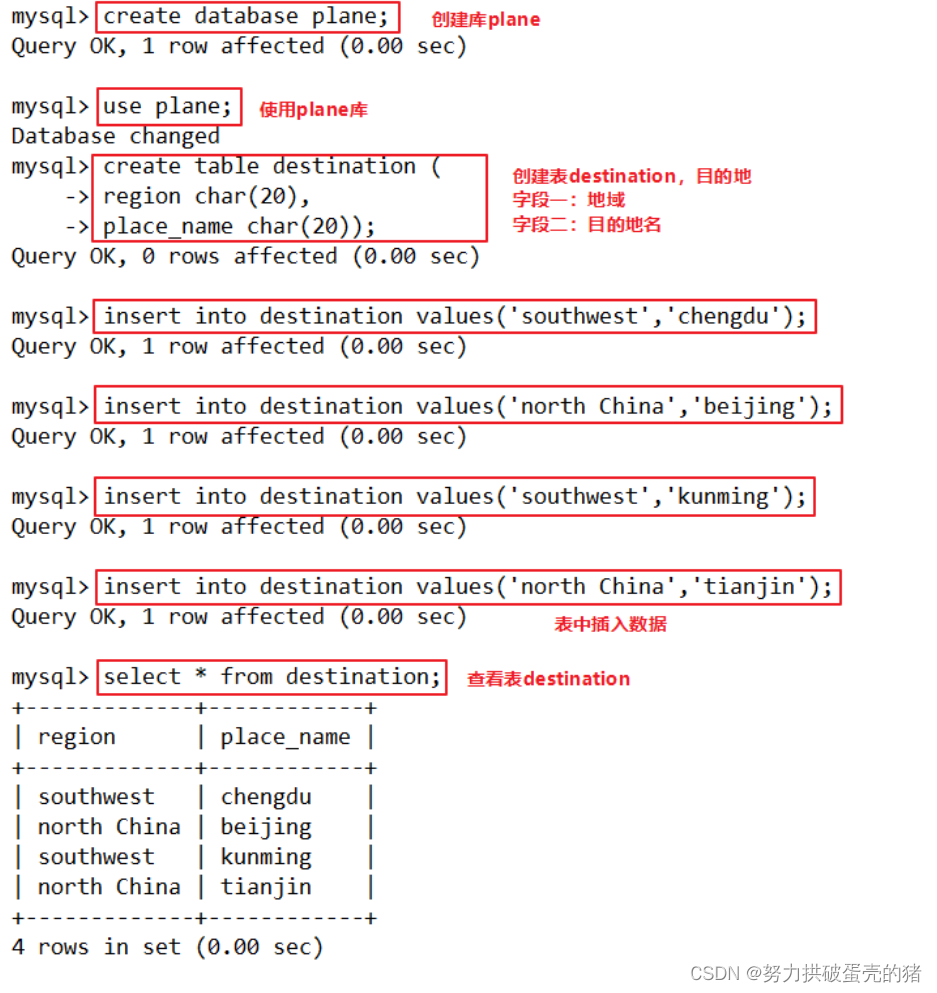
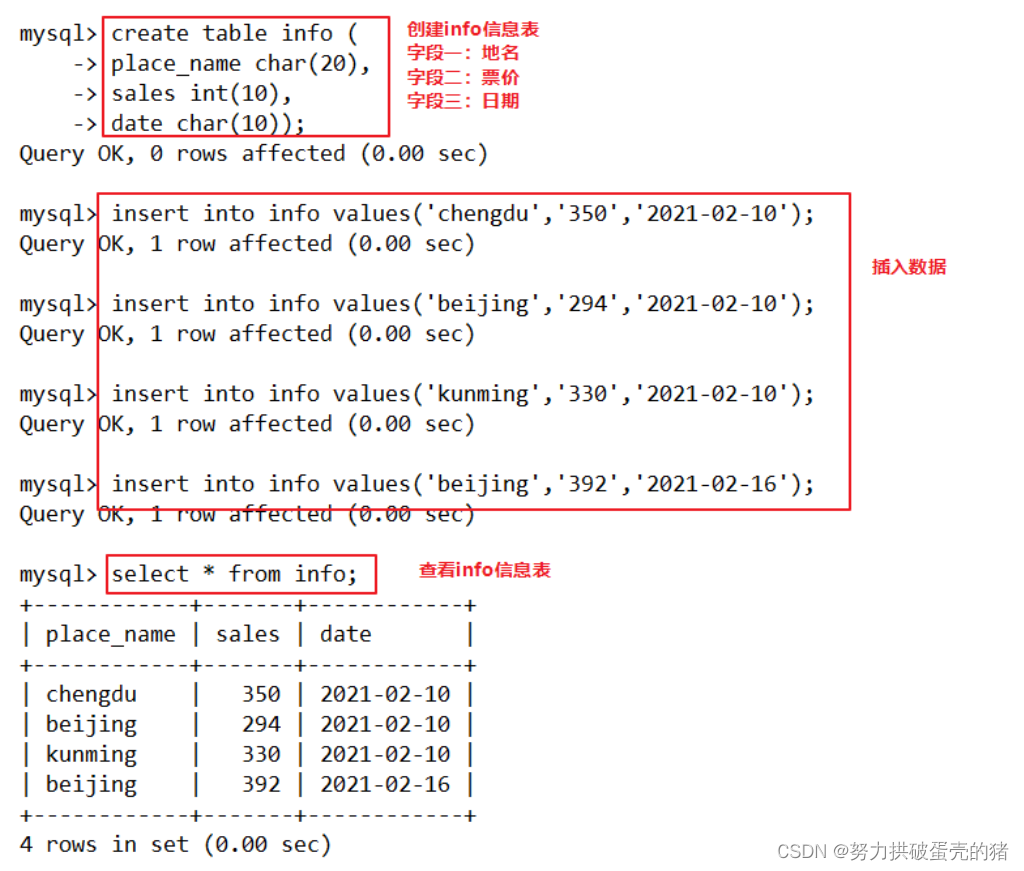
1.SELECT
显示表格中一个或数个栏位的所有资料
语法:SELECT "栏位" FROM "表名";
例:
select region from destination;
select date,sales from info;
select date,sales from info;

2.DISTINST
不显示重复的资料
语法:SELECT DISTINCT "栏位" FROM "表名";
例:
select place_name from info;
select distinct place_name from info;
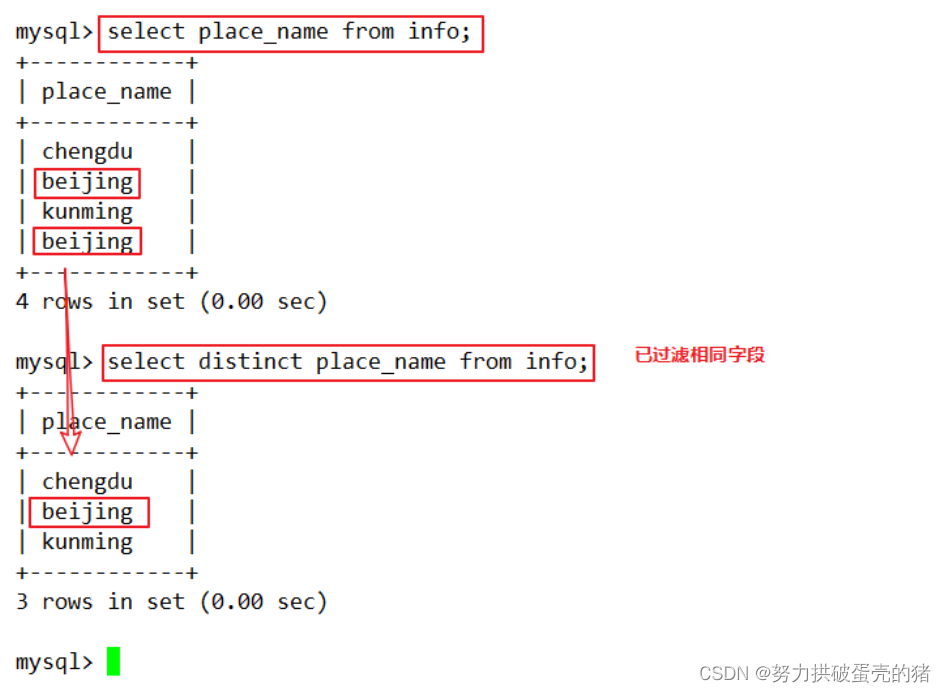
3.WHERE
有条件查询
语法:SELECT "栏位" FROM "表名" WHERE "条件";
例:
select * from info;
select place_name from info where sales > 300;
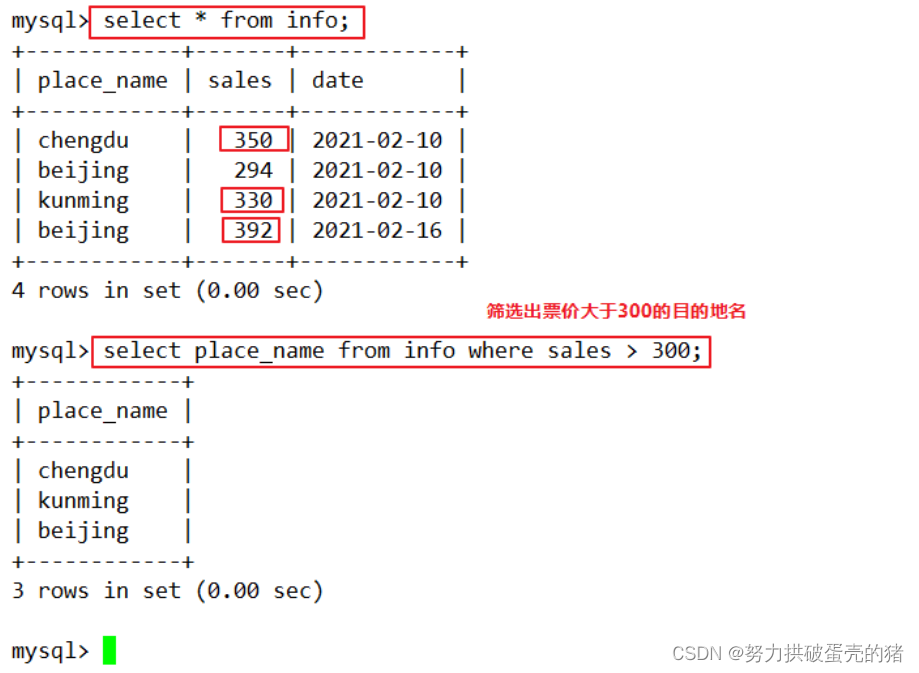
4.AND|OR
且 | 或
语法:SELECT "栏位" FROM "表名" WHERE "条件1" {[AND|OR] "条件2"}+ ;
例:
select * from info;
select place_name from info where sales > 350 or sales < 300;
select place_name from info where sales > 300 and sales < 350;
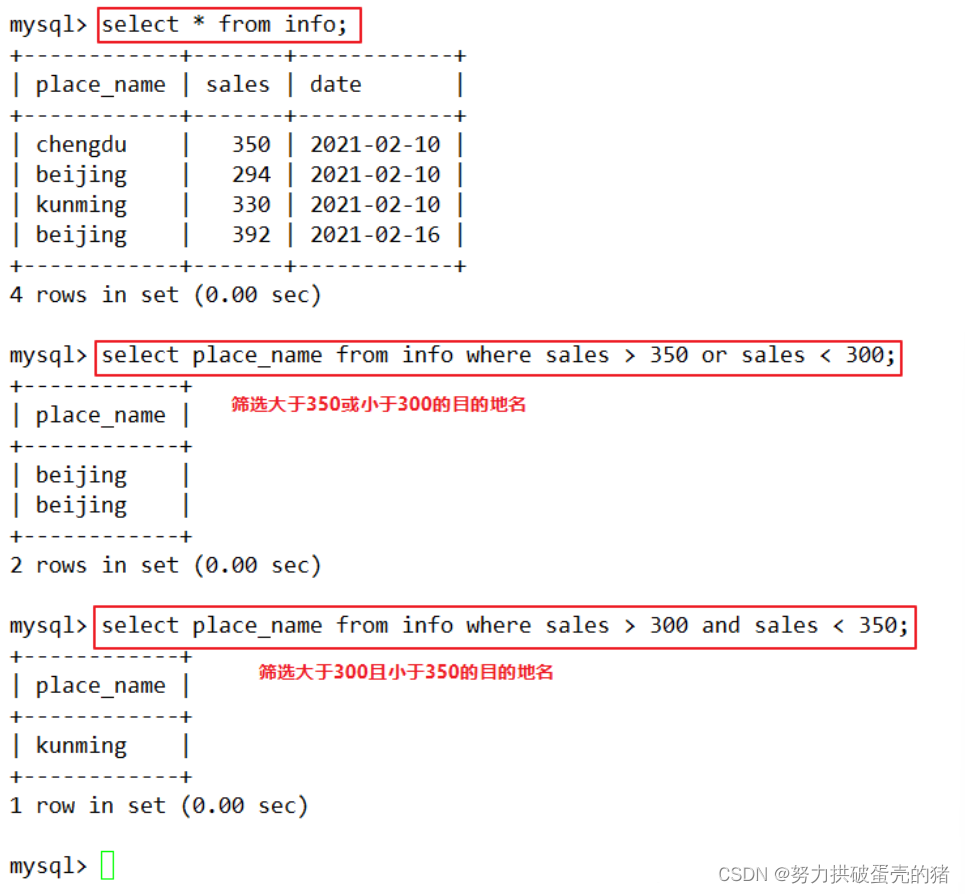 5.IN
5.IN
显示已知的值的资料
语法:SELECT "栏位" FROM "表名" WHERE "栏位" IN ('值1', '值2', ...);
例:
select * from info where place_name in ('beijing');
select * from info where place_name in ('beijing','kunming');

6.BETWEEN
显示两个值范围内的资料
语法:SELECT "栏位" FROM "表名" WHERE "栏位" BETWEEN '值1' AND '值2';
例:
select * from info where sales between '300' and '350';

7.通配符
通常通配符都是跟 LIKE 一起使用的
% :百分号表示零个、一个或多个字符
_ :下划线表示单个字符
例:
'A_Z':所有以 'A' 起头,另一个任何值的字符,且以 'Z' 为结尾的字符串。例如,'ABZ' 和 'A2Z' 都符合这一个模式,而 'AKKZ' 并不符合 (因为在 A 和 Z 之间有两个字符,而不是一个字符)。
'ABC%': 所有以 'ABC' 起头的字符串。例如,'ABCD' 和 'ABCABC' 都符合这个模式。
'%XYZ': 所有以 'XYZ' 结尾的字符串。例如,'WXYZ' 和 'ZZXYZ' 都符合这个模式。
'%AN%': 所有含有 'AN'这个模式的字符串。例如,'LOS ANGELES' 和 'SAN FRANCISCO' 都符合这个模式。
'_AN%':所有第二个字母为 'A' 和第三个字母为 'N' 的字符串。例如,'SAN FRANCISCO' 符合这个模式,而 'LOS ANGELES' 则不符合这个模式。
8.LIKE
匹配一个模式来找出我们要的资料
语法:SELECT "栏位" FROM "表名" WHERE "栏位" LIKE {模式};
例:
select * from info where place_name like '_ei%';
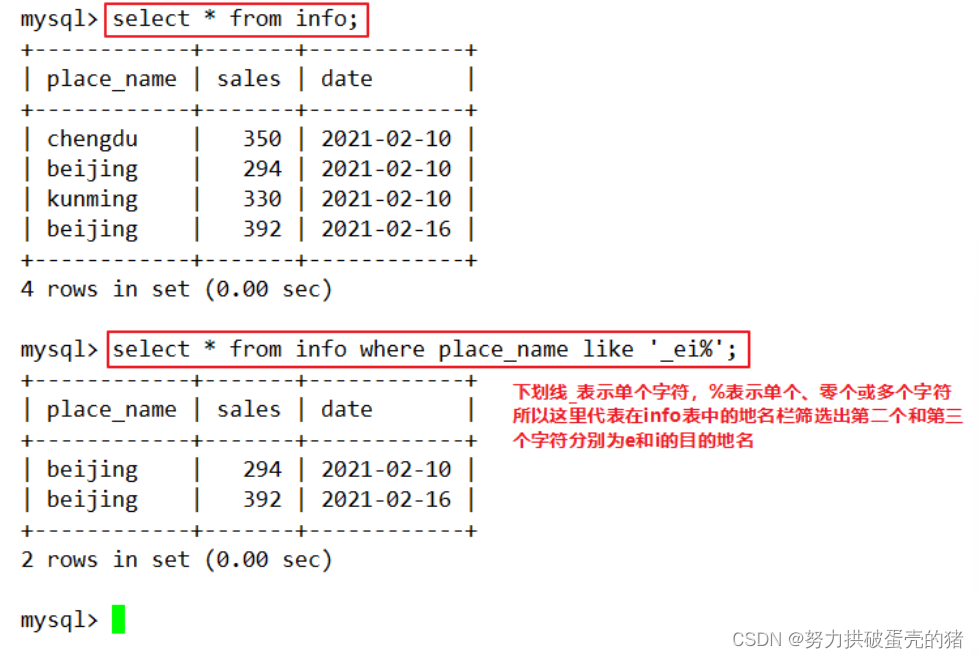
9.ORDER BY
按关键字排序
语法:SELECT "栏位" FROM "表名" [WHERE "条件"] ORDER BY "栏位" [ASC, DESC];
#ASC 是按照升序进行排序的,是默认的排序方式。(Ascending)
#DESC 是按降序方式进行排序。(Descending)
例:
select place_name,sales,date from info order by sales;
select place_name,sales,date from info order by sales asc;
select place_name,sales,date from info order by sales desc;

10.函数
(1)数学函数
abs(x) 返回 x 的绝对值
rand() 返回 0 到 1 的随机数
mod(x,y) 返回 x 除以 y 以后的余数
power(x,y) 返回 x 的 y 次方
round(x) 返回离 x 最近的整数
round(x,y) 保留 x 的 y 位小数四舍五入后的值
sqrt(x) 返回 x 的平方根
truncate(x,y) 返回数字 x 截断为 y 位小数的值
ceil(x) 返回大于或等于 x 的最小整数
floor(x) 返回小于或等于 x 的最大整数
greatest(x1,x2…) 返回集合中最大的值
least(x1,x2…) 返回集合中最小的值
SELECT abs(-1), rand(), mod(5,3), power(2,3), round(1.89);
SELECT round(1.8937,3), truncate(1.235,2), ceil(5.2), floor(2.1), least(1.89,3,6.1,2.1);
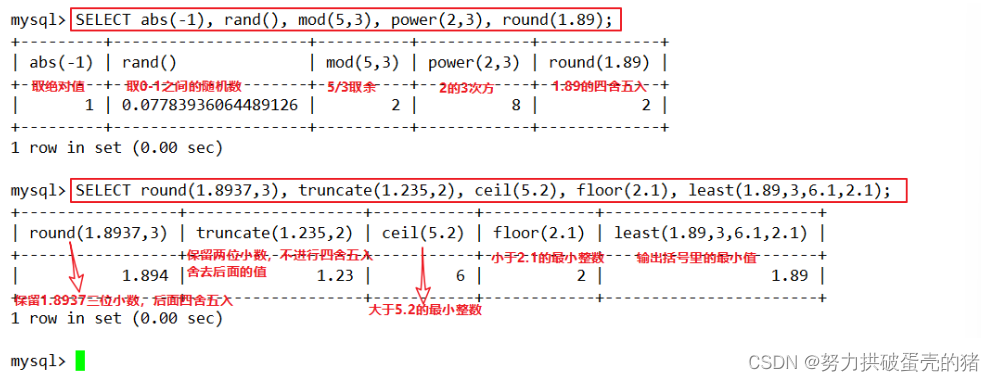
(2)聚合函数
avg() 返回指定列的平均值
count() 返回指定列中非 NULL 值的个数
min() 返回指定列的最小值
max() 返回指定列的最大值
sum(x) 返回指定列的所有值之和
#count(*)包括了所有的列的行数,在统计结果的时候,不会忽略值为NULL
#count(列名)只包括列名那一列的行数,在统计结果的时候,会忽略列值为NULL的行
例:
select avg(sales) from info;
select count(place_name) from info;
select count(distinct place_name) from info;
select max(sales) from info;
select min(sales) from info;
select sum(sales) from info;
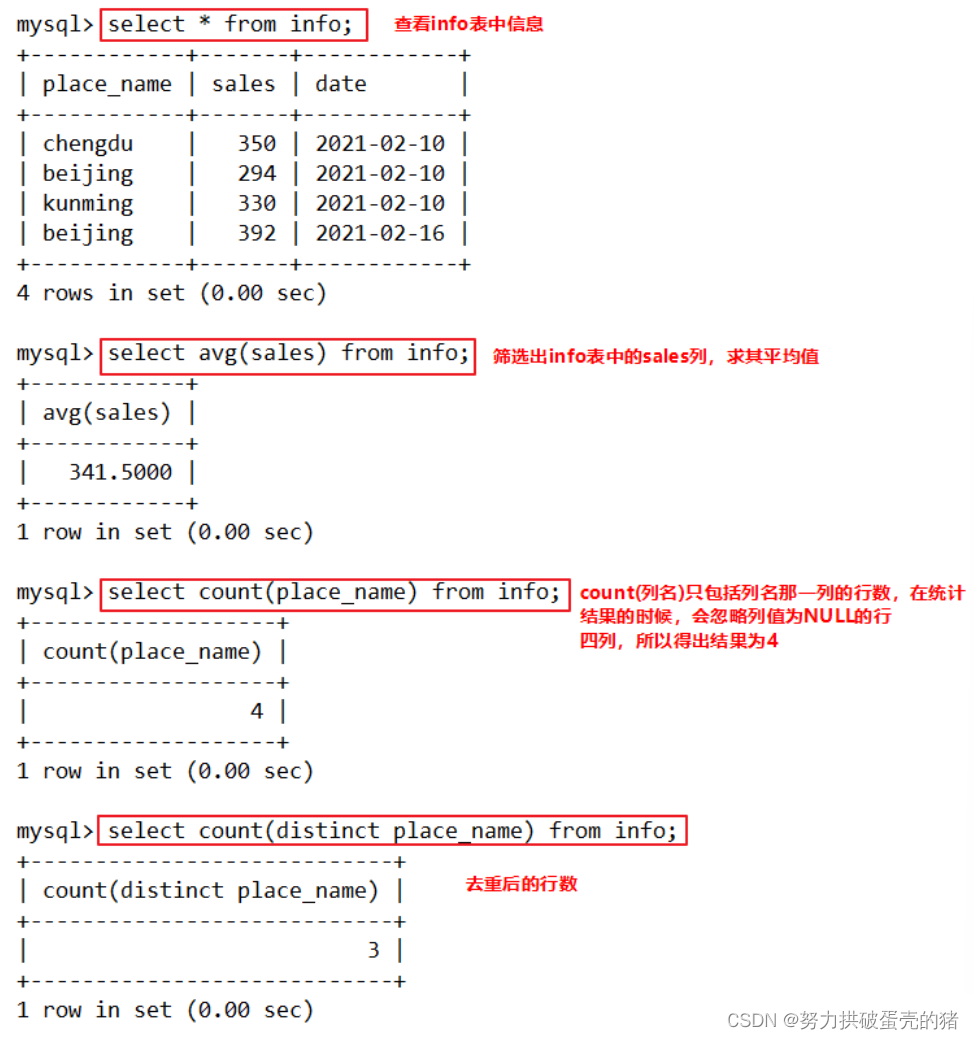
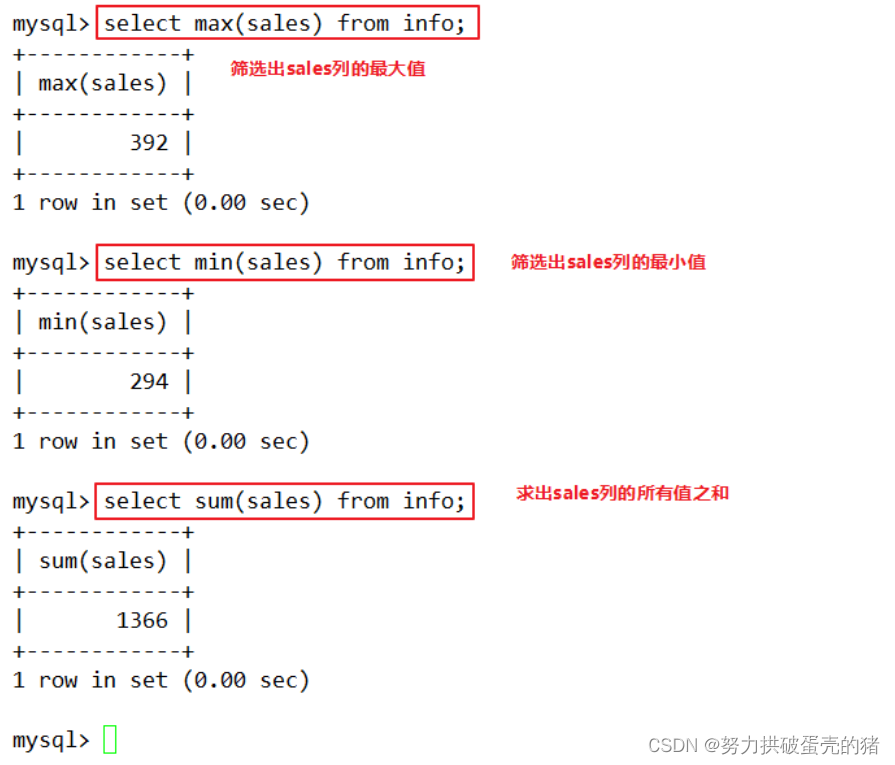
(3)字符串函数
trim() 返回去除指定格式的值
concat(x,y) 将提供的参数 x 和 y 拼接成一个字符串
substr(x,y) 获取从字符串 x 中的第 y 个位置开始的字符串,跟substring()函数作用相同
substr(x,y,z) 获取从字符串 x 中的第 y 个位置开始长度为 z 的字符串
length(x) 返回字符串 x 的长度
replace(x,y,z) 将字符串 z 替代字符串 x 中的字符串 y
upper(x) 将字符串 x 的所有字母变成大写字母
lower(x) 将字符串 x 的所有字母变成小写字母
left(x,y) 返回字符串 x 的前 y 个字符
right(x,y) 返回字符串 x 的后 y 个字符
repeat(x,y) 将字符串 x 重复 y 次
space(x) 返回 x 个空格
strcmp(x,y) 比较 x 和 y,返回的值可以为-1,0,1
reverse(x) 将字符串 x 反转
SELECT concat(Region, Store_Name) FROM location WHERE Store_Name = 'Boston';
#如sql_mode开启了PIPES_AS_CONCAT,"||"视为字符串的连接操作符而非或运算符,和字符串的拼接函数Concat相类似,这和Oracle数据库使用方法一样的
SELECT Region || ' ' || Store_Name FROM location WHERE Store_Name = 'Boston';
SELECT substr(Store_Name,3) FROM location WHERE Store_Name = 'Los Angeles';
SELECT substr(Store_Name,2,4) FROM location WHERE Store_Name = 'New York';
SELECT TRIM ([ [位置] [要移除的字符串] FROM ] 字符串);
#[位置]:的值可以为 LEADING (起头), TRAILING (结尾), BOTH (起头及结尾)。
#[要移除的字符串]:从字串的起头、结尾,或起头及结尾移除的字符串。缺省时为空格。
SELECT TRIM(LEADING 'Ne' FROM 'New York');
SELECT Region,length(Store_Name) FROM location;
SELECT REPLACE(Region,'ast','astern')FROM location;注:如sql_mode开启开启了PIPES_AS_CONCAT,"||"视为字符串的连接操作符而非或运算符,和字符串的拼接函数Concat相类似,这和Oracle数据库使用方法一样的
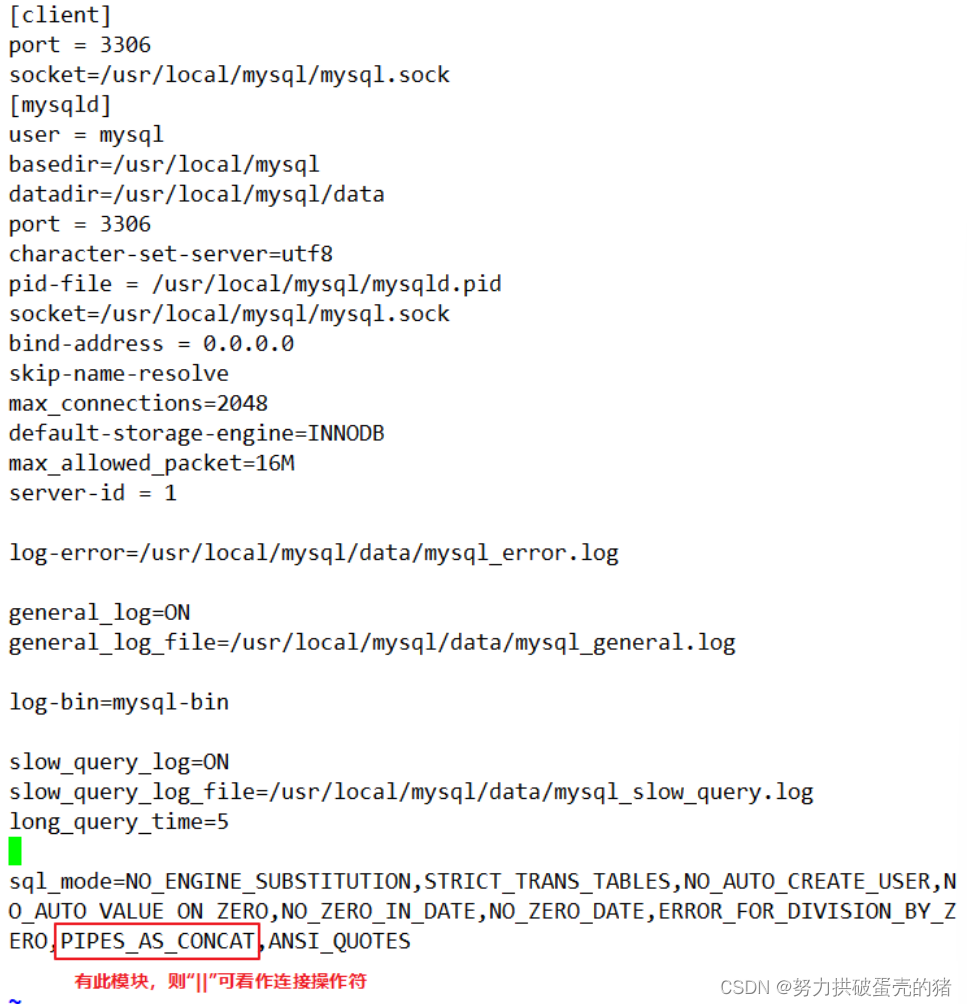
trim() 返回去除指定格式的值
select TRIM ([ [位置] [要移除的字符串] from ] 字符串);
#[位置]:的值可以为 LEADING (起头), TRAILING (结尾), BOTH (起头及结尾)。
#[要移除的字符串]:从字串的起头、结尾,或起头及结尾移除的字符串。缺省时为空格。
例:
select trim(leading '123' from '1234567');
 concat(x,y) 将提供的参数 x 和 y 拼接成一个字符串
concat(x,y) 将提供的参数 x 和 y 拼接成一个字符串
select concat(region, place_name) from destination;
select region || ' ' || place_name from destination;
select region || ' ' || place_name from destination where place_name = 'beijing';
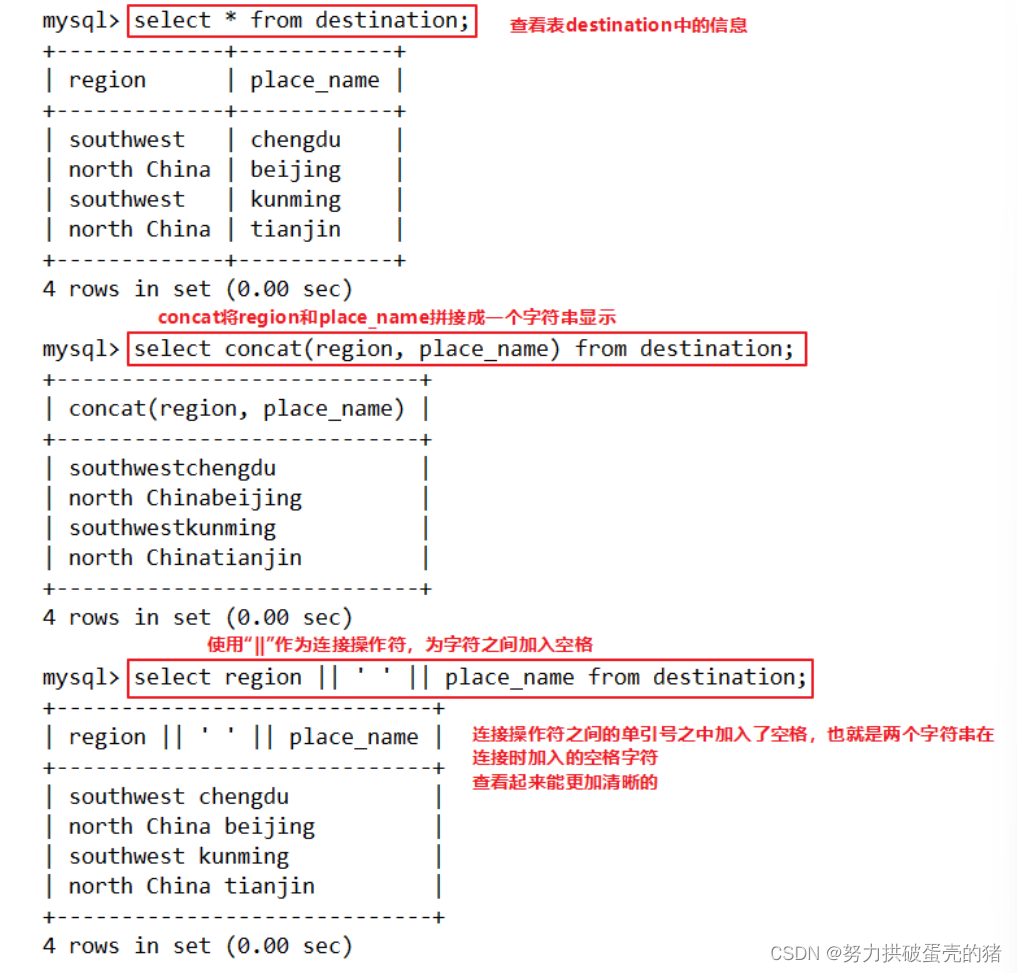

substr(x,y) 获取从字符串 x 中的第 y 个位置开始的字符串,跟substring()函数作用相同
substr(x,y,z) 获取从字符串 x 中的第 y 个位置开始长度为 z 的字符串
select * from destination;
select substr(place_name,3) from destination where place_name = 'beijing';
select substr(place_name,2,4) from destination where place_name = 'beijing';
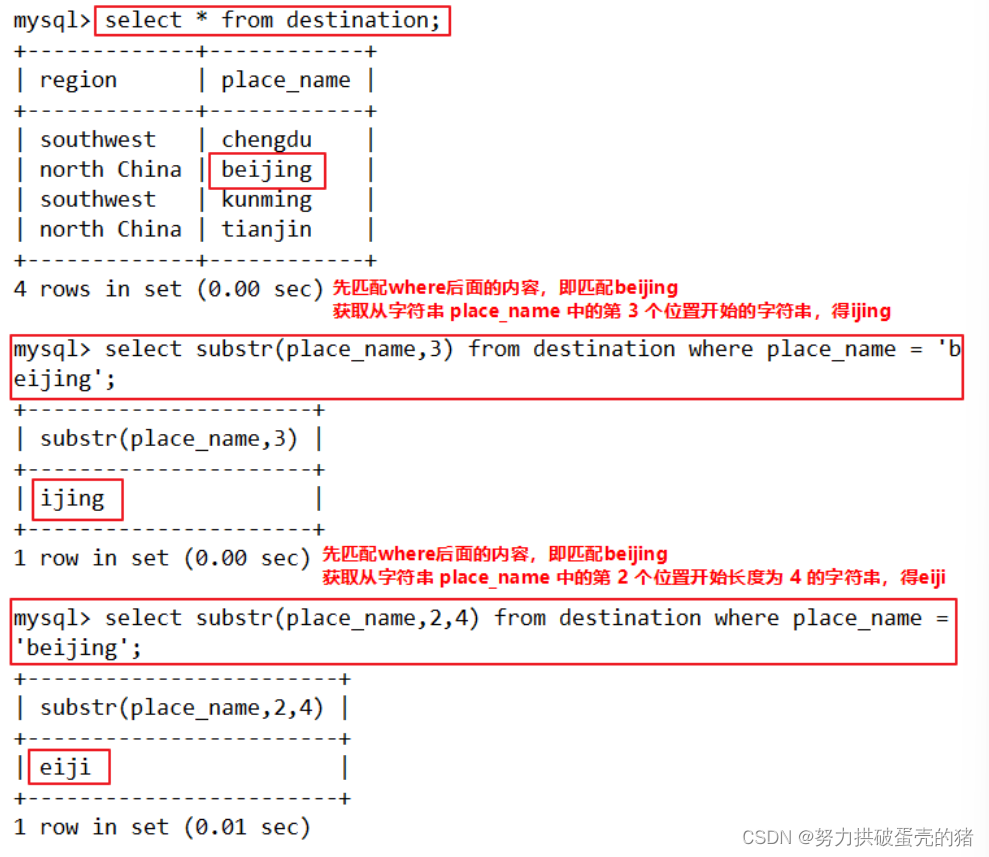
length(x) 返回字符串 x 的长度
select place_name from destination;
select length(place_name) from destination;
select region,length(place_name) from destination;
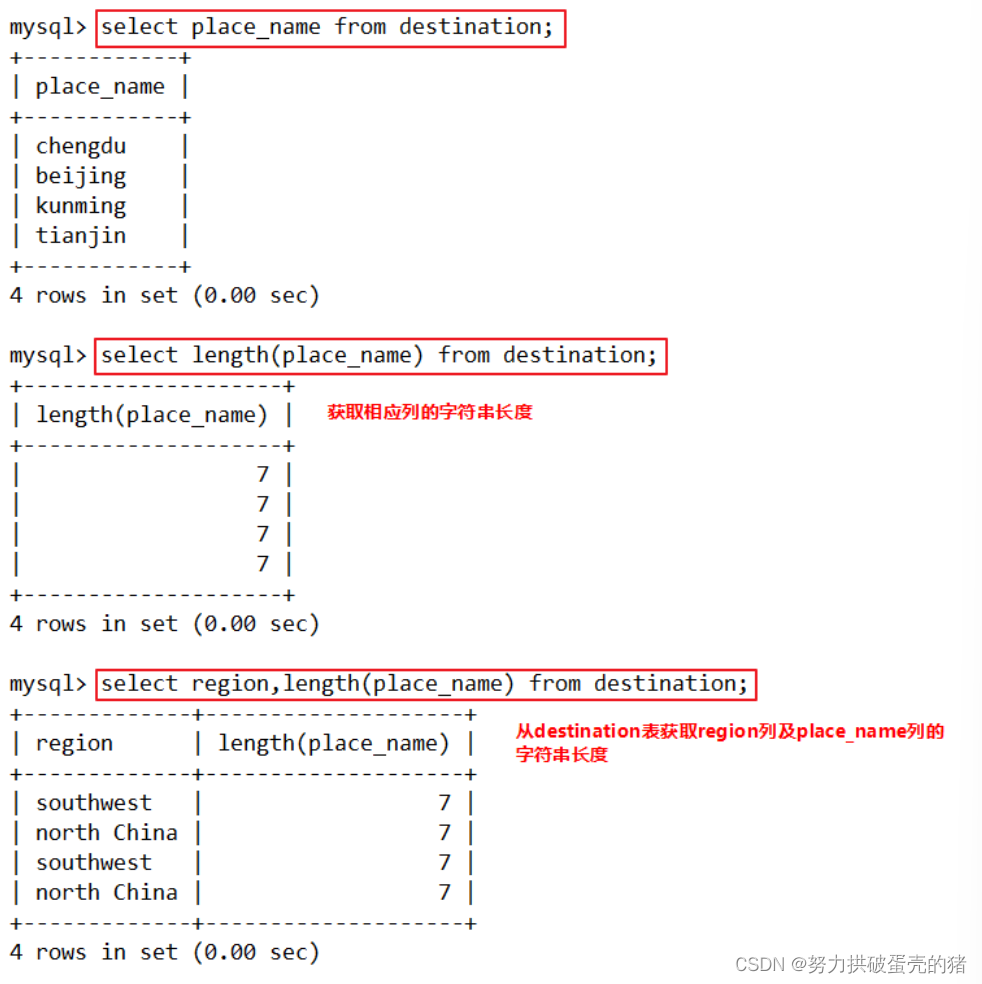
replace(x,y,z) 将字符串 z 替代字符串 x 中的字符串 y
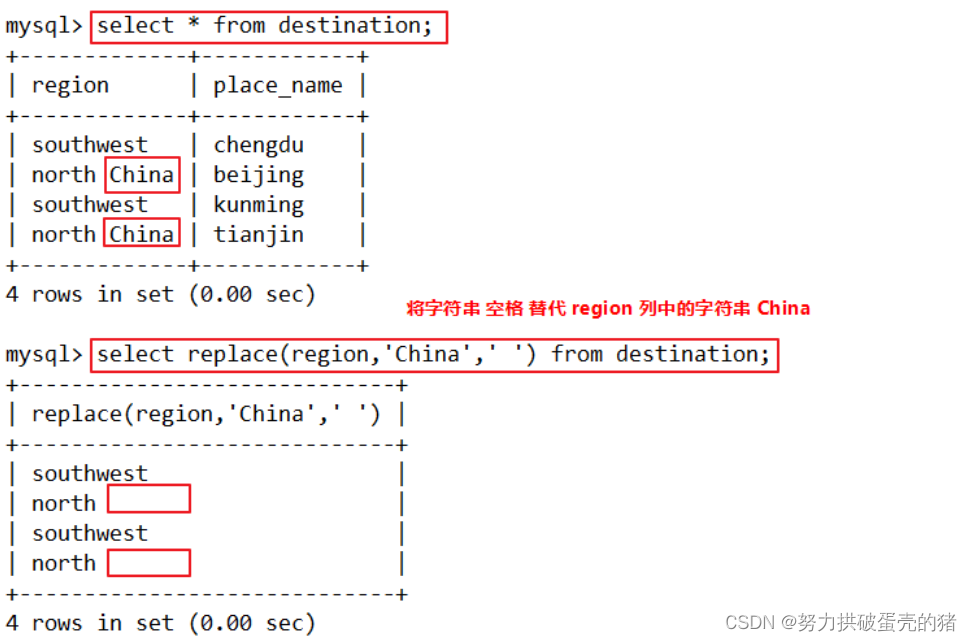
upper(x) 将字符串 x 的所有字母变成大写字母
lower(x) 将字符串 x 的所有字母变成小写字母
select * from destination;
select upper(region) from destination;
select lower(region) from destination;
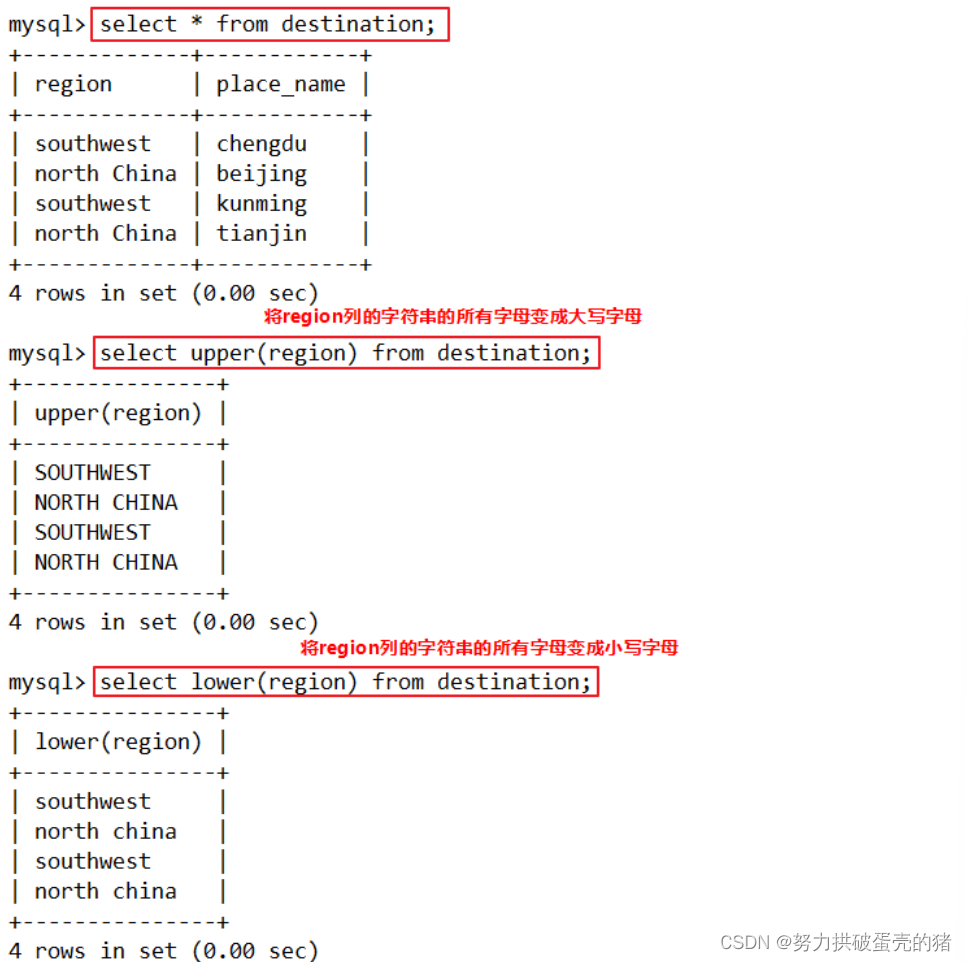
left(x,y) 返回字符串 x 的前 y 个字符
right(x,y) 返回字符串 x 的后 y 个字符
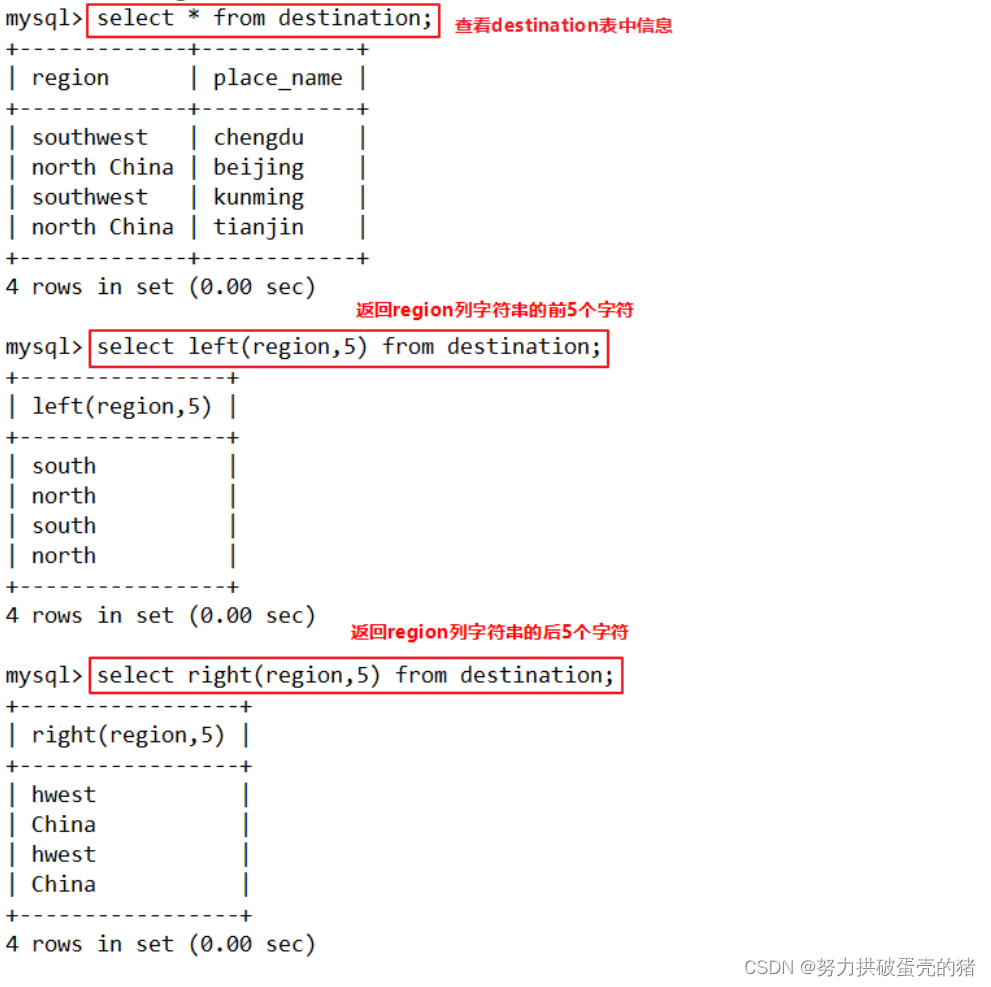 repeat(x,y) 将字符串 x 重复 y 次
repeat(x,y) 将字符串 x 重复 y 次
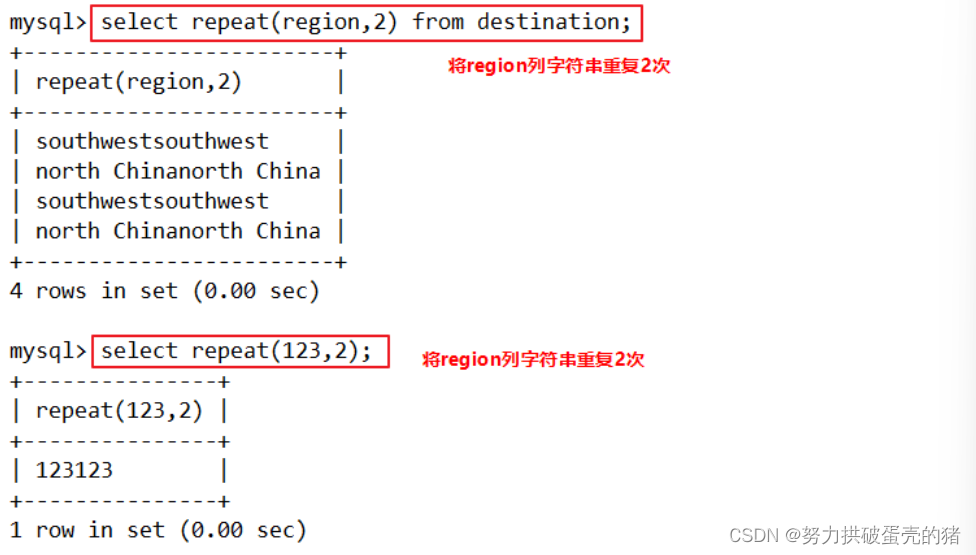
space(x) 返回 x 个空格
select space(20);
select space(10);
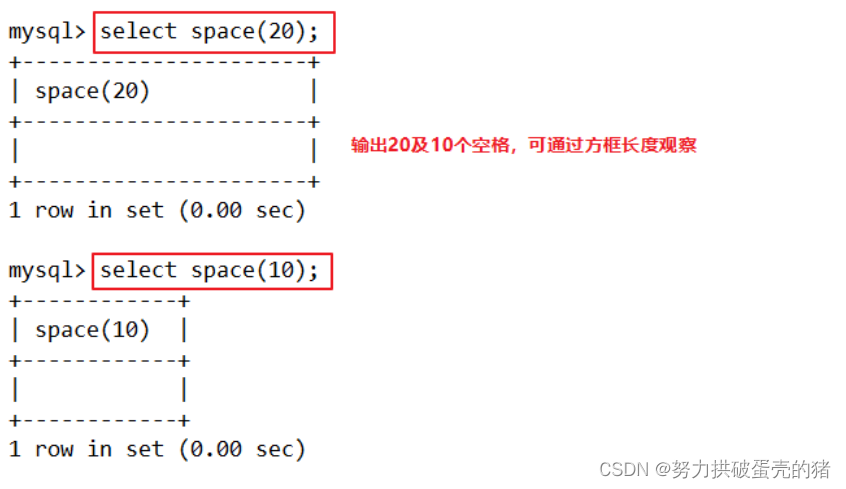
strcmp(x,y) 比较 x 和 y,返回的值可以为-1,0,1
select strcmp(5,6);
select strcmp(5,5);
select strcmp(6,5);
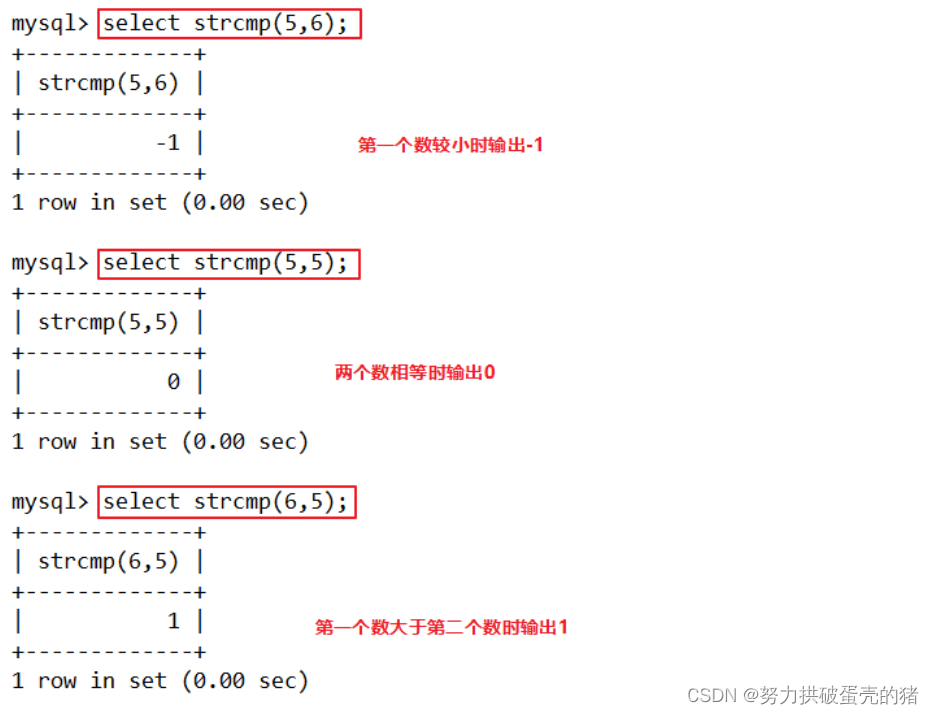
reverse(x) 将字符串 x 反转

11.GROUP BY
对GROUP BY后面的字段的查询结果进行汇总分组,通常是结合聚合函数一起使用的
注:
1)GROUP BY 有一个原则,就是 SELECT 后面的所有列中,没有使用聚合函数的列,必须出现在GROUP BY后面。
2)凡是在 SELECT 后面出现的、且未在聚合函数中出现的字段,必须出现在 GROUP BY 后面
语法:SELECT "栏位1", SUM("栏位2") FROM "表名" GROUP BY "字段1";
例:
select place_name,sum(sales) from info group by place_name order by sum(sales);
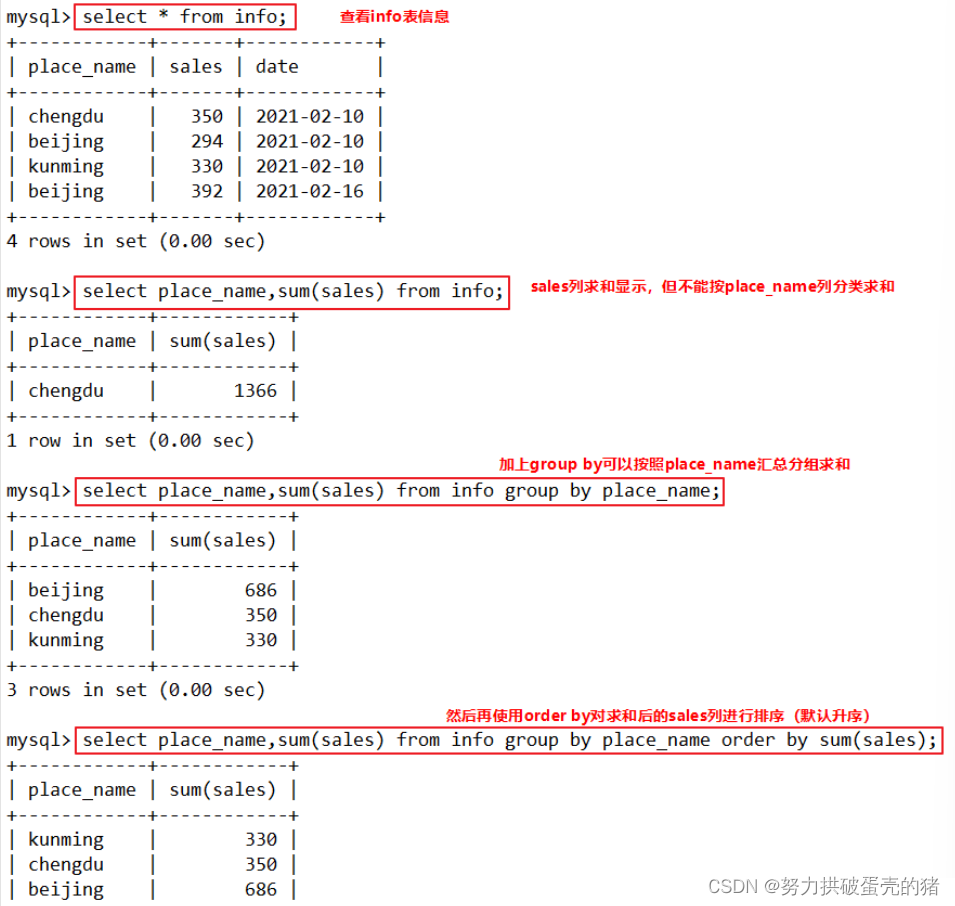
12.HAVING
用来过滤由GROUP BY 语句返回的记录表
注:
1)通常与GROUP BY语句联合使用
2)HAVING语句的存在弥补了WHERE关键字不能与聚合函数联合使用的不足。如果被SELECT的只有函数栏,那就不需要GROUP BY子句。
语法:SELECT "栏位1", SUM("栏位2") FROM "表格名" GROUP BY "栏位1" HAVING (函数条件);
例:
select place_name,sum(sales) from info group by place_name having sum(sales) > 400;

13.别名
栏位別名,表格別名
语法:SELECT "表格別名"."栏位1" [AS] "栏位別名" FROM "表格名" [AS] "表格別名";
例:
select A.place_name "name",sum(A.sales) "sum_sales" from info A group by name;

14.子查询
连接表格,在WHERE 子句或 HAVING 子句中插入另一个 SQL 语句
语法:
#外查询
SELECT "栏位1" FROM "表格1" WHERE "栏位2" [比较运算符]
#内查询
(SELECT "栏位1" FROM "表格2" WHERE "条件");
#可以是符号的运算符,例如 =、>、<、>=、<= ;也可以是文字的运算符,例如 LIKE、IN、BETWEEN
SELECT SUM(Sales) FROM Store_Info WHERE Store_Name IN
(SELECT Store_Name FROM location WHERE Region = 'West');
SELECT SUM(A.Sales) FROM Store_Info A WHERE A.Store_Name IN
(SELECT Store_Name FROM location B WHERE B.Store_Name = A.Store_Name);例1:
select sum(sales) from info where place_name in (select place_name from destination where region = 'southwest');
#下面这个句子就是上面的简化版
select sum(sales) from info where place_name in('chengdu','kunming');
例2:
select sum(a.sales) from info a where a.place_name in(select place_name from destination b where b.place_name = a.place_name);
select sum(a.sales) from info a where a.place_name in(select place_name from destination b where b.place_name = a.place_name);


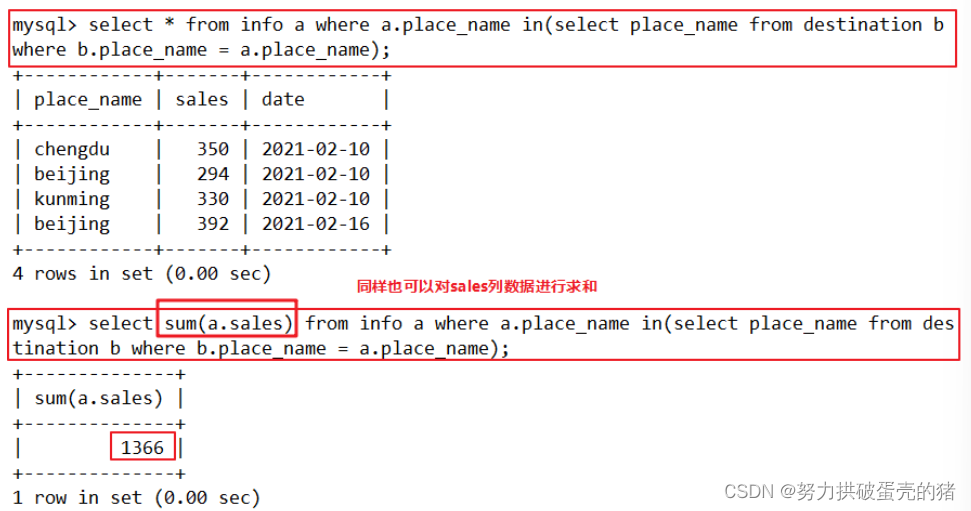
15.EXISTS
用来测试内查询有没有产生任何结果
- 用来测试内查询有没有产生任何结果,类似布尔值是否为真
- 如果有的话,系统就会执行外查询中的SQL语句。若是没有的话,那整个 SQL 语句就不会产生任何结果。
语法:SELECT "栏位1" FROM "表格1" WHERE EXISTS (SELECT * FROM "表格2" WHERE "条件");
例:
select sum(sales) from info where exists (select * from destination where region = 'southwest');
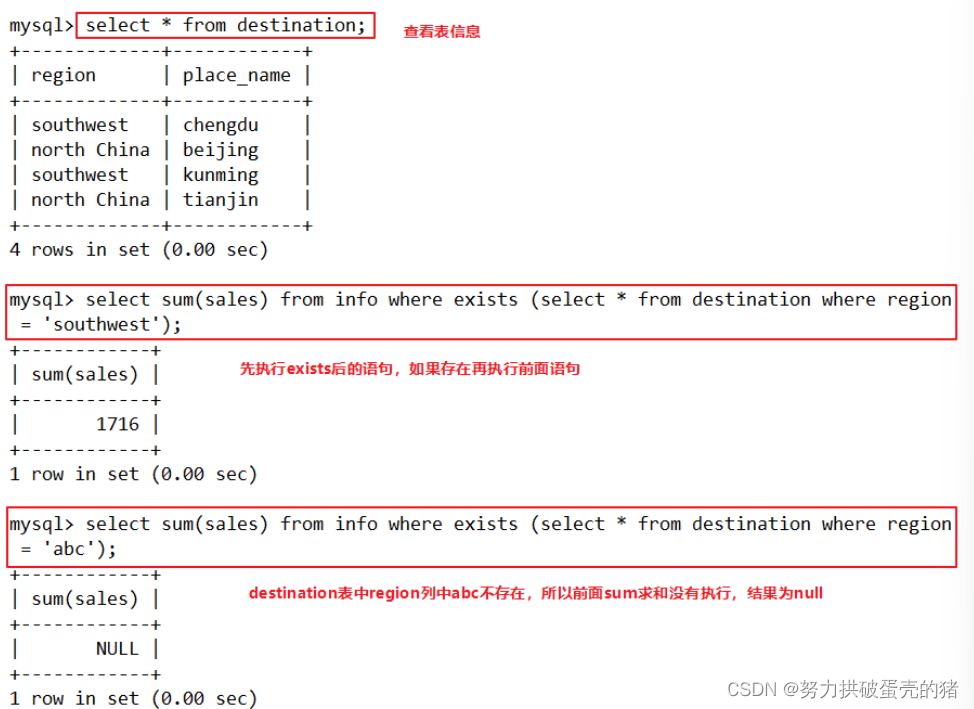
二:连接查询
inner join(内连接):只返回两个表中联结字段相等的行
left join(左连接):返回包括左表中的所有记录和右表中联结字段相等的记录
right join(右连接):返回包括右表中的所有记录和左表中联结字段相等的记录
SELECT * FROM location A RIGHT JOIN Store_Info B on A.Store_Name = B.Store_Name ;
SELECT * FROM location A LEFT JOIN Store_Info B on A.Store_Name = B.Store_Name ;
内连接一:
SELECT * FROM location A INNER JOIN Store_Info B on A.Store_Name = B.Store_Name ;
内连接二:
SELECT * FROM location A, Store_Info B WHERE A.Store_Name = B.Store_Name;
SELECT A.Region REGION, SUM(B.Sales) SALES FROM location A, Store_Info B
WHERE A.Store_Name = B.Store_Name GROUP BY REGION;
1、inner join(等值相连)
只返回两个表中联结字段相等的行
SELECT * FROM 表1 表1的别名 INNER JOIN 表2 表2的别名 on 表1别名.栏位 = 表2别名.栏位; #这里的栏位名称相同
例:
select * from destination a inner join info b on a.place_name = b.place_name;

2、left join(左联接)
返回包括左表中的所有记录和右表中联结字段相等的记录
SELECT * FROM 表1 表1的别名 LEFT JOIN 表2 表2的别名 on 表1别名.栏位 = 表2别名.栏位; #这里的栏位名称相同
例:
select * from destination a left join info b on a.place_name = b.place_name;

3、right join(右联接)
返回包括右表中的所有记录和左表中联结字段相等的记录
SELECT * FROM 表1 表1的别名 RIGHT JOIN 表2 表2的别名 on 表1别名.栏位 = 表2别名.栏位; #这里的栏位名称相同
例:
select * from destination a right join info b on a.place_name = b.place_name;

三、CREATE VIEW 视图
- 视图跟表格的不同是,表格中有实际储存资料,而视图是建立在表格之上的一个架构,它本身并不实际储存资料。
- 临时表在用户退出或同数据库的连接断开后就自动消失了,而视图不会消失。
- 视图不含有数据,只存储它的定义,它的用途一般可以简化复杂的查询。比如你要对几个表进行连接查询,而且还要进行统计排序等操作,写SQL语句会很麻烦的,用视图将几个表联结起来,然后对这个视图进行查询操作,就和对一个表查询一样,很方便。
语法:CREATE VIEW "视图表名" AS "SELECT 语句"; CREATE VIEW V_REGION_SALES AS SELECT A.Region REGION,SUM(B.Sales) SALES FROM location A INNER JOIN Store_Info B ON A.Store_Name = B.Store_Name GROUP BY REGION; SELECT * FROM V_REGION_SALES; DROP VIEW V_REGION_SALES;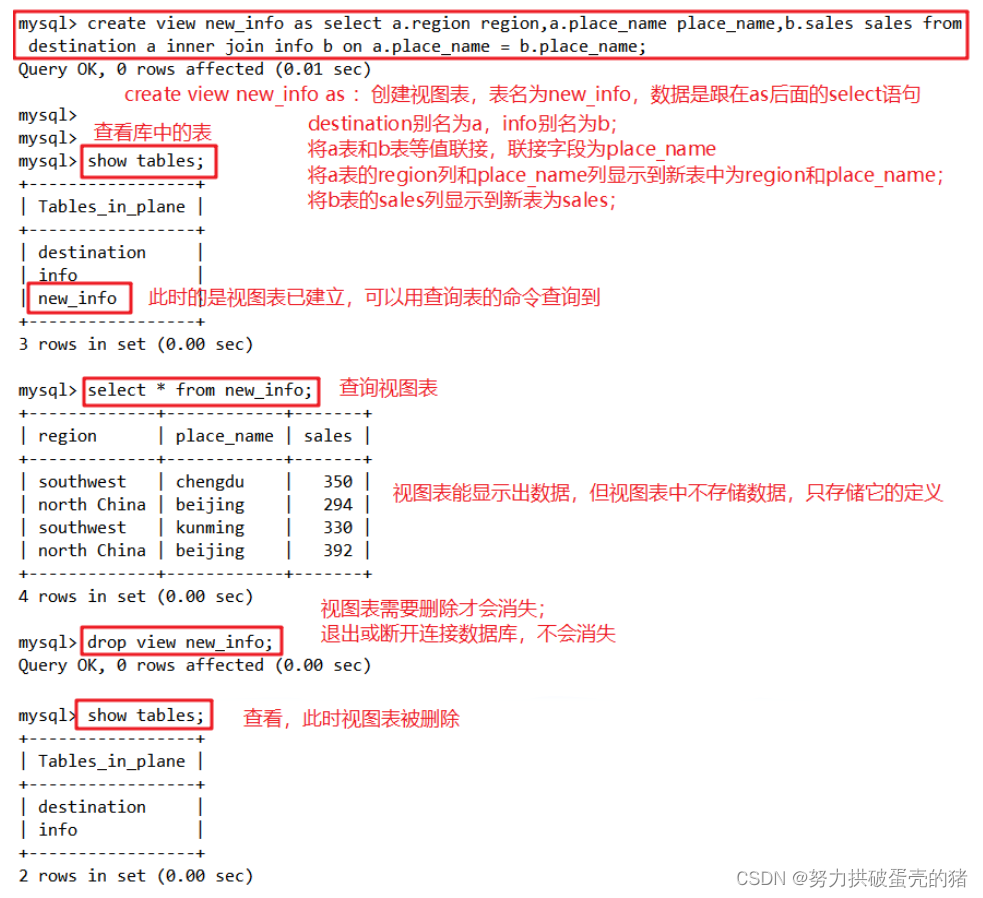
四、MySQL之联集、交集值、无交集值、case
1、联集
将两个SQL语句的结果合并起来,两个SQL语句所产生的栏位需要是同样的资料种类
(1)UNION
UNION :生成结果的资料值将没有重复,且按照字段的顺序进行排序
语法:[SELECT 语句 1] UNION [SELECT 语句 2];
例:
select place_name from destination union select place_name from info;

(2)UNION ALL
UNION ALL :将生成结果的资料值都列出来,无论有无重复
语法:[SELECT 语句 1] UNION ALL [SELECT 语句 2];
例:
select place_name from destination union all select place_name from info;
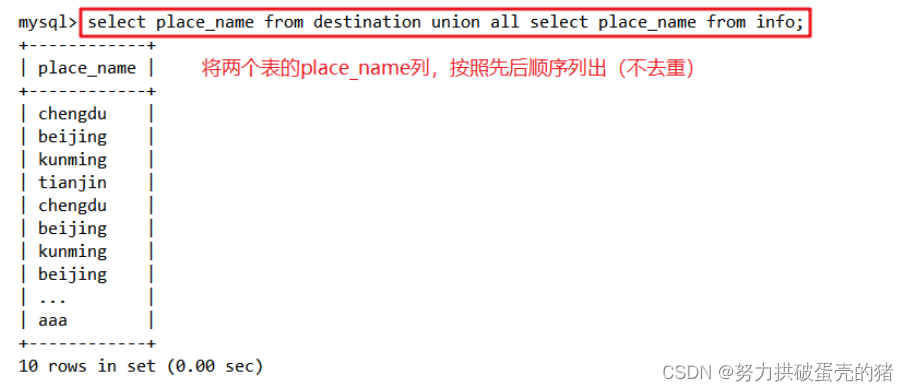
2、交集值
#取两个SQL语句结果的交集
SELECT A.Store_Name FROM location A INNER JOIN Store_Info B ON A.Store_Name = B.Store_Name;
SELECT A.Store_Name FROM location A INNER JOIN Store_Info B USING(Store_Name);
#取两个SQL语句结果的交集,且没有重复
SELECT DISTINCT A.Store_Name FROM location A INNER JOIN Store_Info B USING(Store_Name);
SELECT DISTINCT Store_Name FROM location WHERE (Store_Name) IN (SELECT Store_Name FROM Store_Info);
SELECT DISTINCT A.Store_Name FROM location A LEFT JOIN Store_Info B USING(Store_Name) WHERE B.Store_Name IS NOT NULL;
SELECT A.Store_Name FROM (SELECT B.Store_Name FROM location B INNER JOIN Store_Info C ON B.Store_Name = C.Store_Name) A
GROUP BY A.Store_Name;
SELECT A.Store_Name FROM
(SELECT DISTINCT Store_Name FROM location UNION ALL SELECT DISTINCT Store_Name FROM Store_Info) A
GROUP BY A.Store_Name HAVING COUNT(*) > 1;
(1)取两个SQL语句结果的交集
select a.place_name from destination a inner join info b on a.place_name = b.place_name;

(2)两表没用重复的行,并且确实有交集的时候用
select a.place_name from (select place_name from destination union all select place_name from info) a group by a.place_name having count(*) > 1;
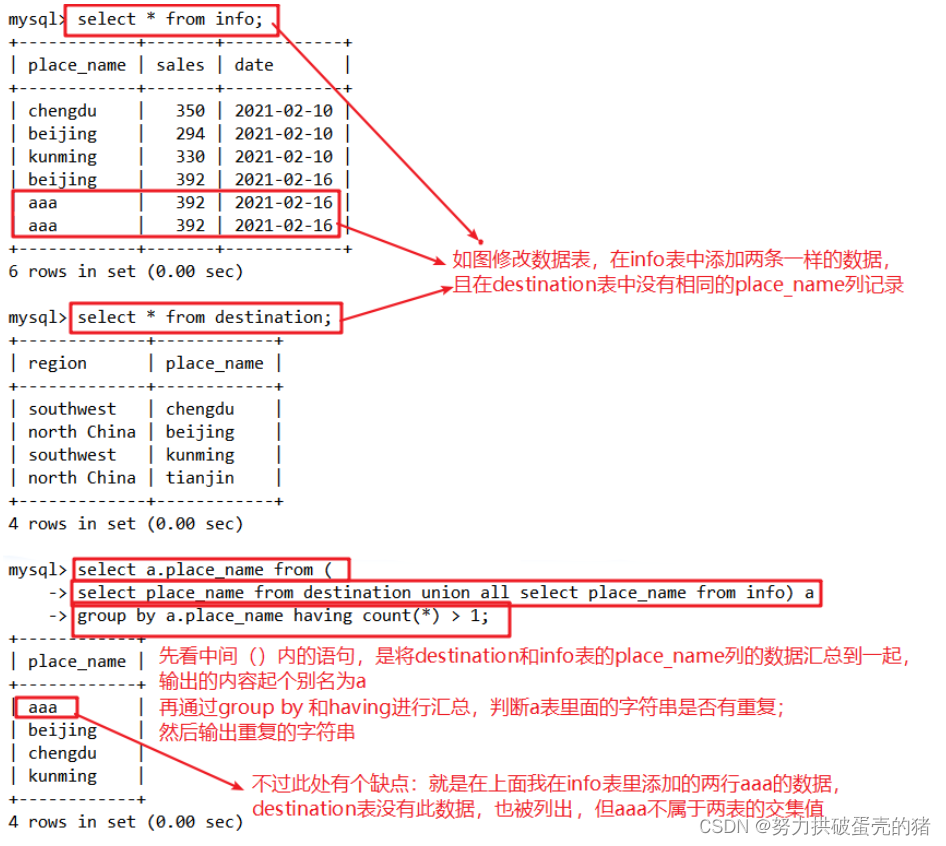
(3)取两个SQL语句结果的交集,且没有重复
select a.place_name from (select b.place_name from destination b inner join info c on b.place_name =c.place_name) a group by a.place_name;
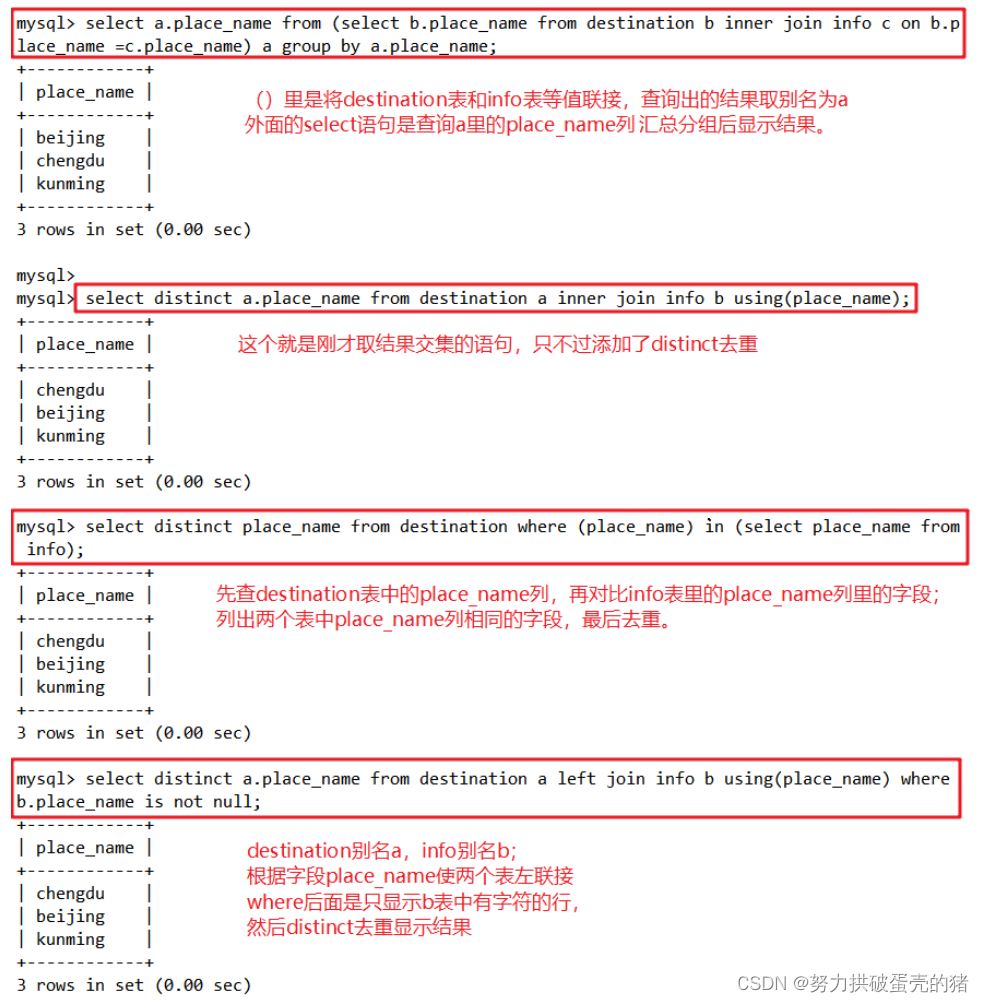
3、无交集值
显示第一个SQL语句的结果,且与第二个SQL语句没有交集的结果,且没有重复
SELECT DISTINCT Store_Name FROM location WHERE (Store_Name) NOT IN (SELECT Store_Name FROM Store_Info);
SELECT DISTINCT A.Store_Name FROM location A LEFT JOIN Store_Info B USING(Store_Name) WHERE B.Store_Name IS NULL;
SELECT A.Store_Name FROM
(SELECT DISTINCT Store_Name FROM location UNION ALL SELECT DISTINCT Store_Name FROM Store_Info) A
GROUP BY A.Store_Name HAVING COUNT(*) = 1;
select distinct place_name from destination where (place_name) not in (select place_name from info);
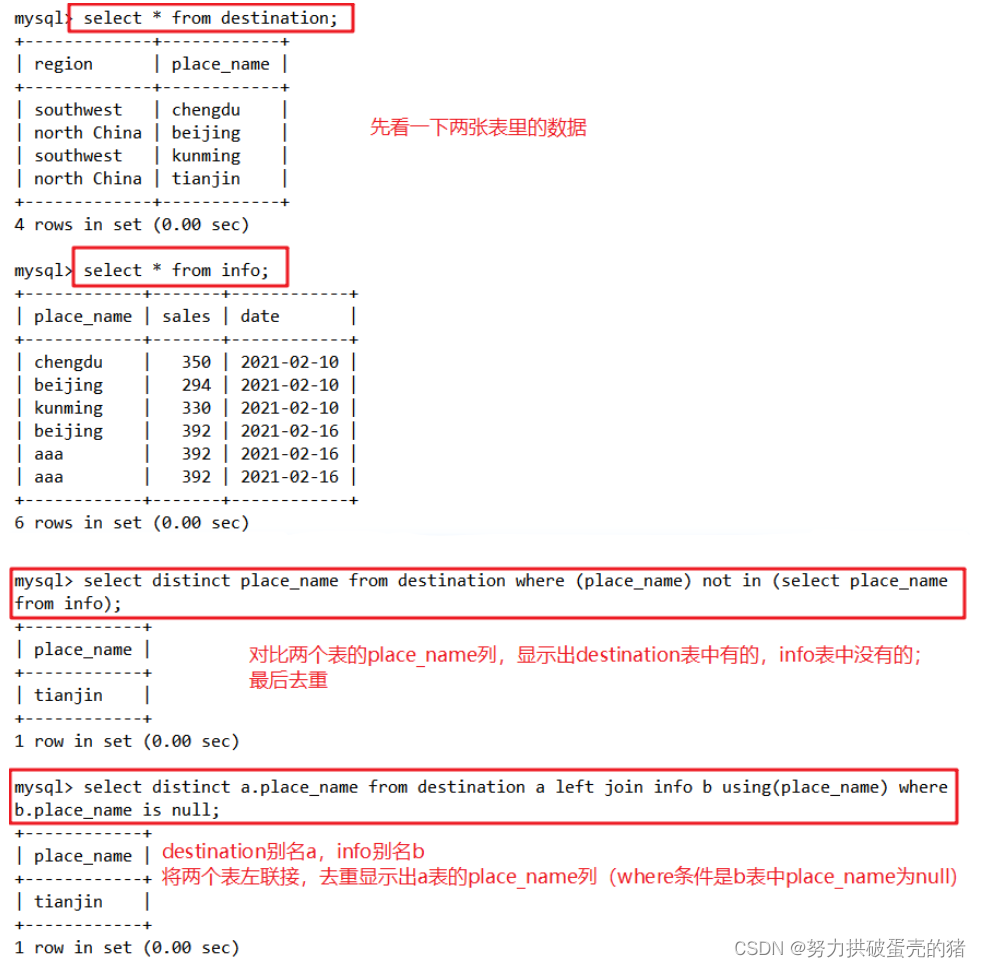
4、CASE
CASE是 SQL 用来做为 IF-THEN-ELSE 之类逻辑的关键字
语法:
SELECT CASE ("字段名")
WHEN "条件1" THEN "结果1"
WHEN "条件2" THEN "结果2"
...
[ELSE "结果N"]
END
FROM "表名";
# "条件" 可以是一个数值或是公式。 ELSE 子句则并不是必须的。
SELECT Store_Name, CASE Store_Name
WHEN 'Los Angeles' THEN Sales * 2
WHEN 'Boston' THEN 2000
ELSE Sales
END
"New Sales",Date
FROM Store_Info;
#"New Sales" 是用于 CASE 那个字段的字段名。
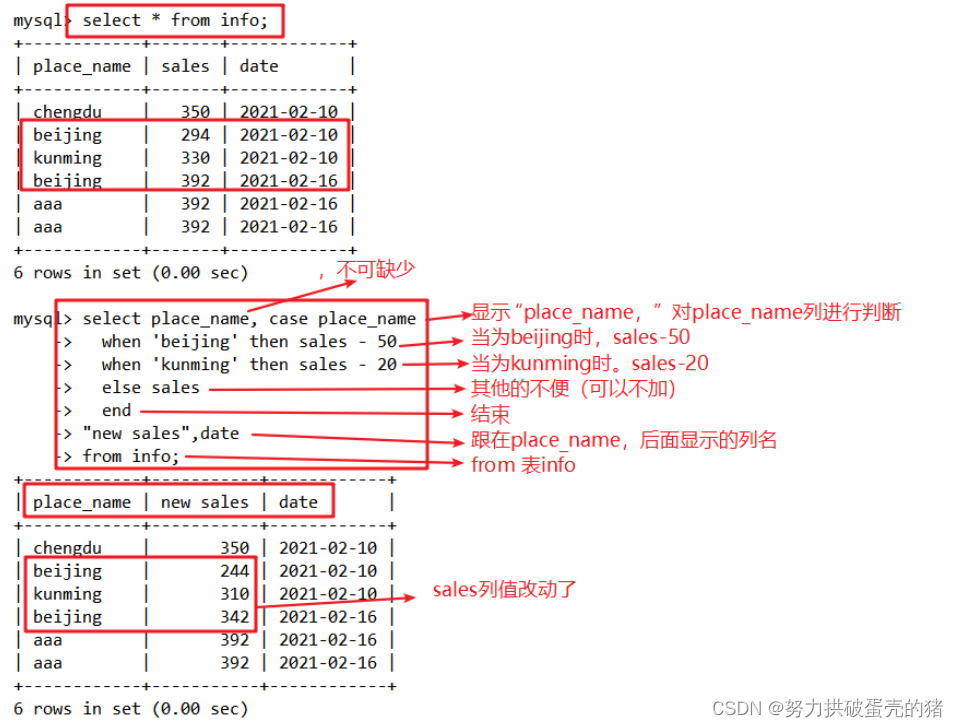
五、排序
在排序前先准备下用来实验的表格
create database school;
use school;
create table class(name varchar(20),scores int(5));
insert into class values ('aa1',80);
insert into class values ('bb2',100);
insert into class values ('cc3',78);
insert into class values ('dd4',94);
insert into class values ('ee5',66);
insert into class values ('ff6',53);
insert into class values ('gg7',77);
select * from class;
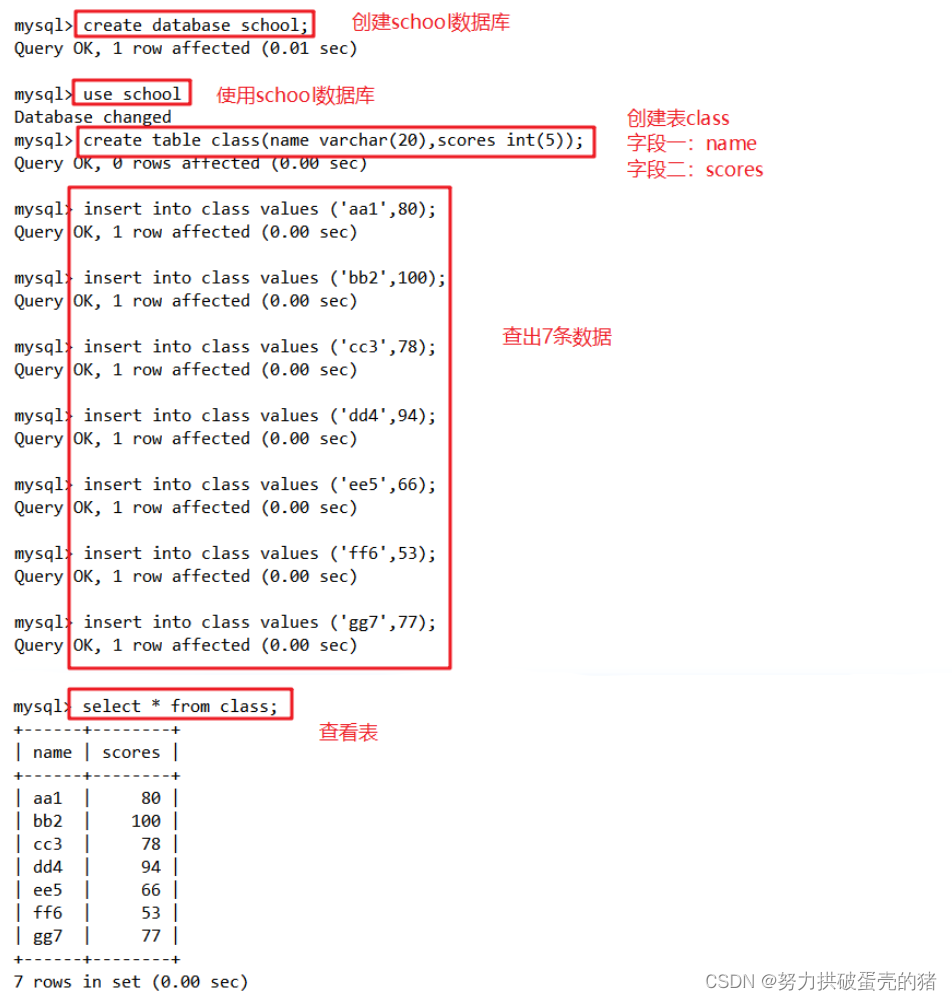
1、算排名
表格自我连结 (Self Join),然后将结果依序列出,算出每一行之前 (包含那一行本身) 有多少行数
select a1.name, a1.scores,count(a2.scores) rank from class a1,class a2 where a1.scores < a2.scores or (a1.scores = a2.scores and a1.name = a2.name) group by a1.name,a1.scores order by a1.scores desc;
#统计scores栏位的值是比自己本身的值小的以及scores栏位和name栏位都相同的数量,比如ff6为6+1=7
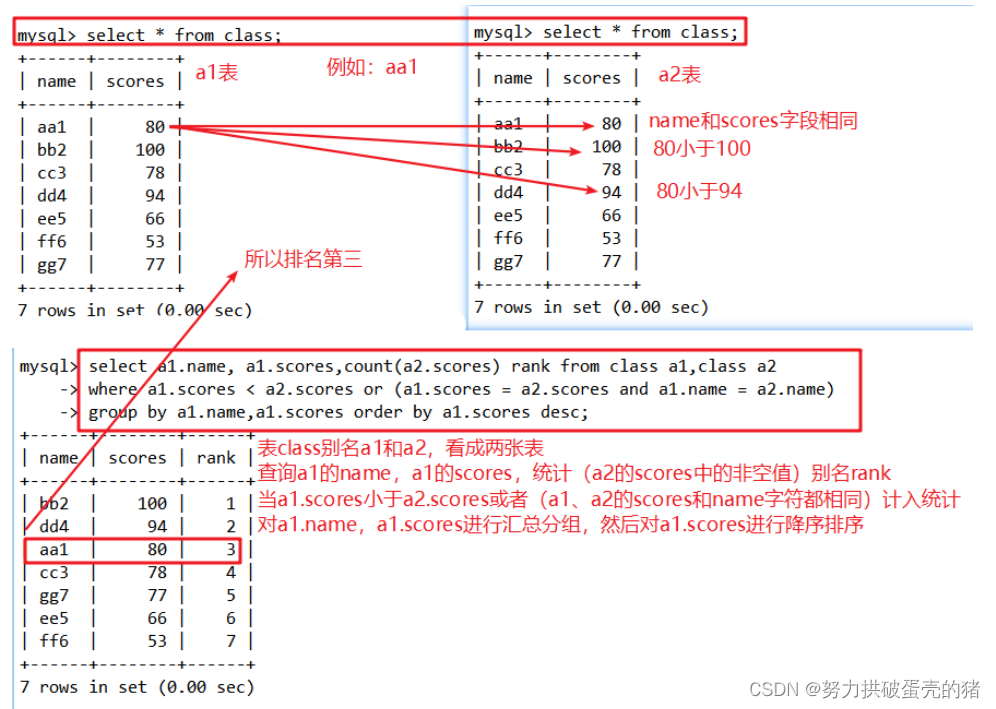
2、算中位数
select scores middle from (select a1.name, a1.scores,count(a2.scores) rank from class a1,class a2 where a1.scores < a2.scores or (a1.scores = a2.scores and a1.name <= a2.name) group by a1.name,a1.scores order by a1.scores desc) a3 where a3.rank = (select (count(*)+1) div 2 from class);
#每个派生表必须有自己的别名,所以别名 A3 必须要有
#DIV 是在 MySQL 中算出商的方式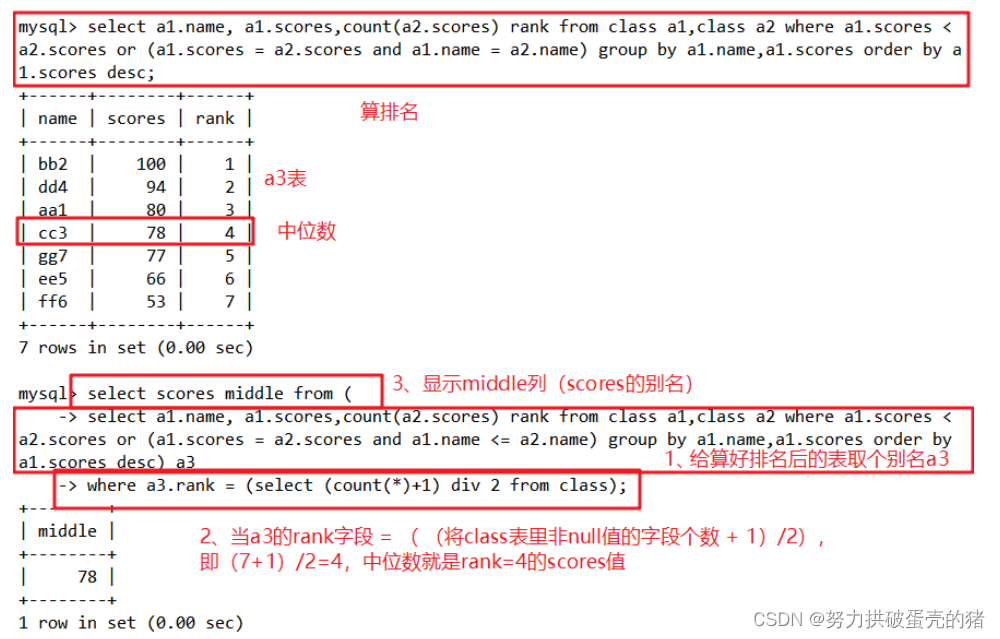
3、算累积总计
表格自我连结 (Self Join),然后将结果依序列出,算出每一行之前 (包含那一行本身) 的总合
select A1.*,sum(A2.scores) sum_socores from class A1,class A2 where A1.scores < A2.scores or(A1.scores = A2.scores and A1.name = A2.name) group by A1.name order by A1.scores desc;
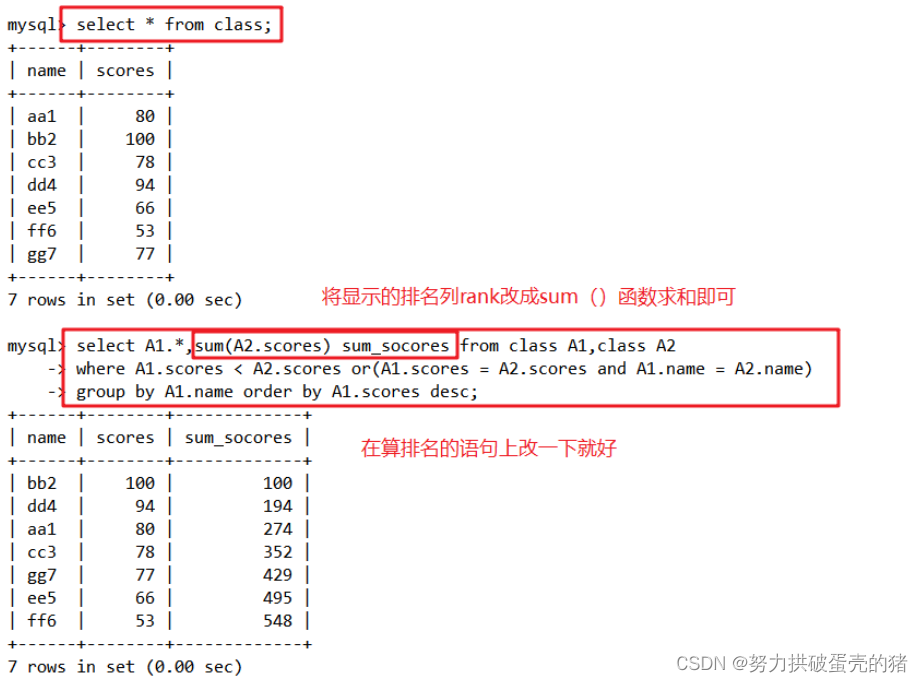
4、算总合百分比
select A1.*,A1.scores/(select sum(scores) from class) per_sum from class A1,class A2 where A1.scores < A2.scores or (A1.scores = A2.scores and A1.name=A2.name) group by A1.name order by A1.scores desc;
#SELECT SUM(Sales) FROM Total_Sales 这一段子查询是用来算出总合
#总合算出后,我们就能够将每一行一一除以总合来求出每一行的总合百分比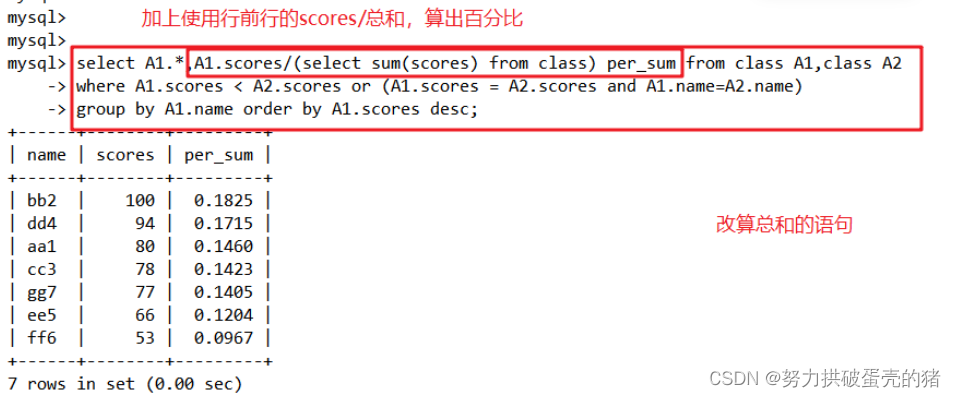
5、算累积总合百分比
(1)用累积总计 SUM(a2.Sales) 除以总合来求出每一行的累积总合百分比
select A1.name,A1.scores,sum(A2.scores),sum(A2.scores)/(select sum(scores) from class) per_sum from class A1,class A2 where A1.scores < A2.scores or (A1.scores = A2.scores and A1.name=A2.name) group by A1.name order by A1.scores desc;
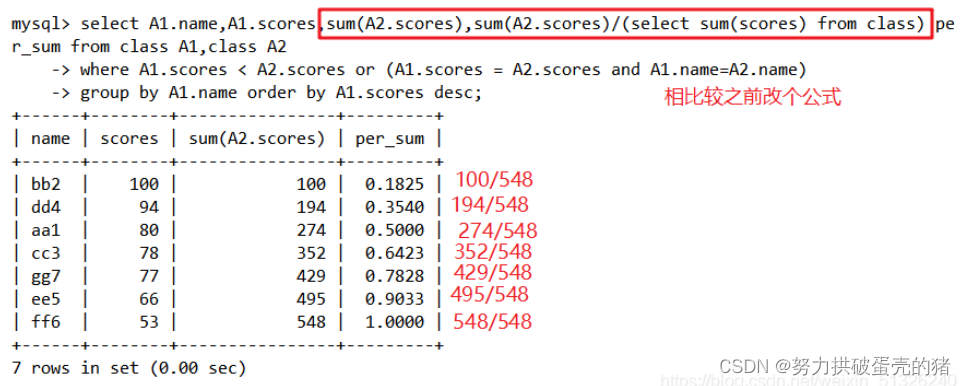
(2)取小数点后几位数
select A1.name,A1.scores,sum(A2.scores),truncate(sum(A2.scores)/(select sum(scores) from class),2) ||'%' per_sum from class A1,class A2 where A1.scores < A2.scores or (A1.scores = A2.scores and A1.name=A2.name) group by A1.name order by A1.scores desc;
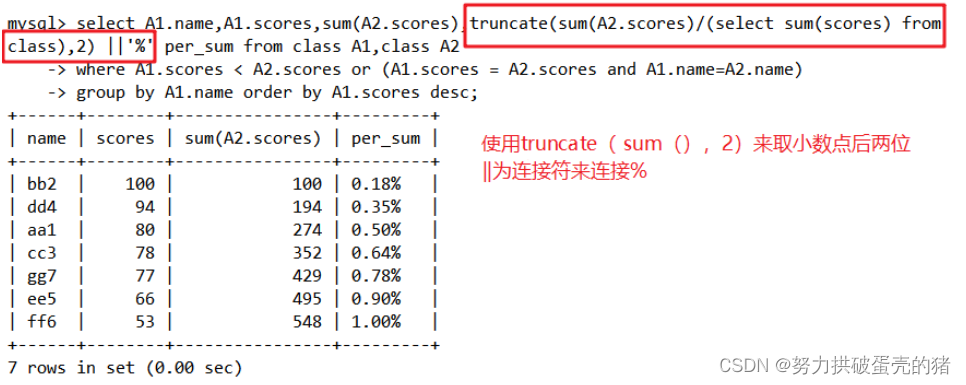
六、空值(NULL) 和 无值(’’) 的区别
- 无值的长度为 0,不占用空间的;而 NULL 值的长度是 NULL,是占用空间的。
- IS NULL 或者 IS NOT NULL,是用来判断字段是不是为 NULL 或者不是 NULL,不能查出是不是无值的。
- 无值的判断使用=’‘或者<>’'来处理。<> 代表不等于。
- 在通过 count()指定字段统计有多少行数时,如果遇到 NULL 值会自动忽略掉,遇到无值会加入到记录中进行计算。
City 表格
+----------+
| name |
|----------|
| beijing |
| nanjing |
| shanghai |
| <null> |
| <null> |
| shanghai |
| |
+----------+
SELECT length(NULL), length(''), length('1');
SELECT * FROM City WHERE name IS NULL;
SELECT * FROM City WHERE name IS NOT NULL;
SELECT * FROM City WHERE name = '';
SELECT * FROM City WHERE name <> '';
SELECT COUNT(*) FROM City;
SELECT COUNT(name) FROM City;
测试:
#建表
create table test(test varchar(20));
insert into test values(' ');
insert into test values('123123');
insert into test values();
insert into test values('1111');
insert into test values('');
select * from test;
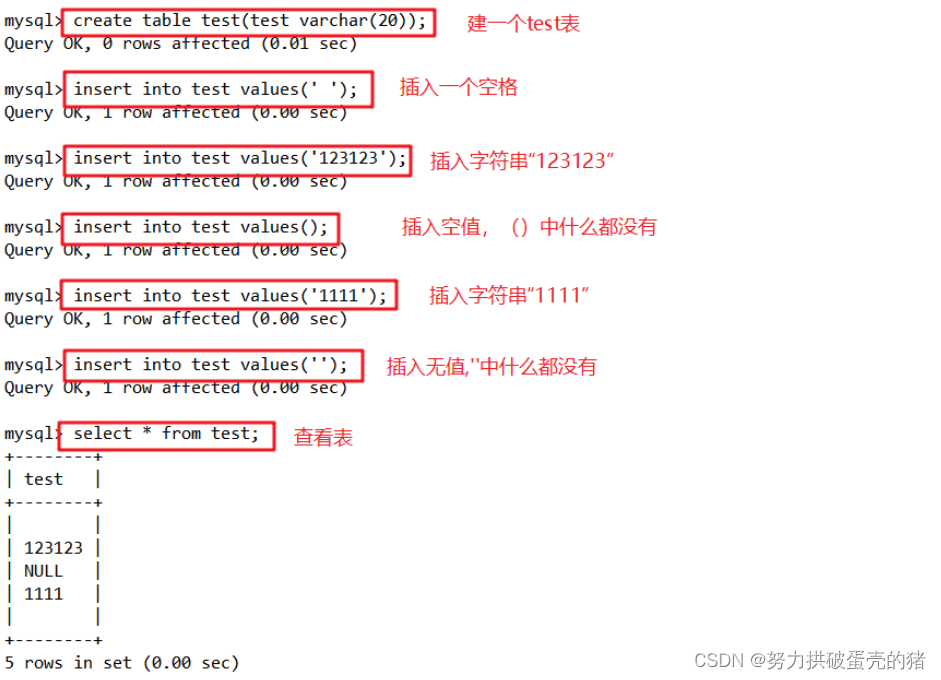
例:
select * from test where test is null;
select * from test where test is not null;
select * from test where test = '';
select * from test where test <> '';
select count(test) from test;
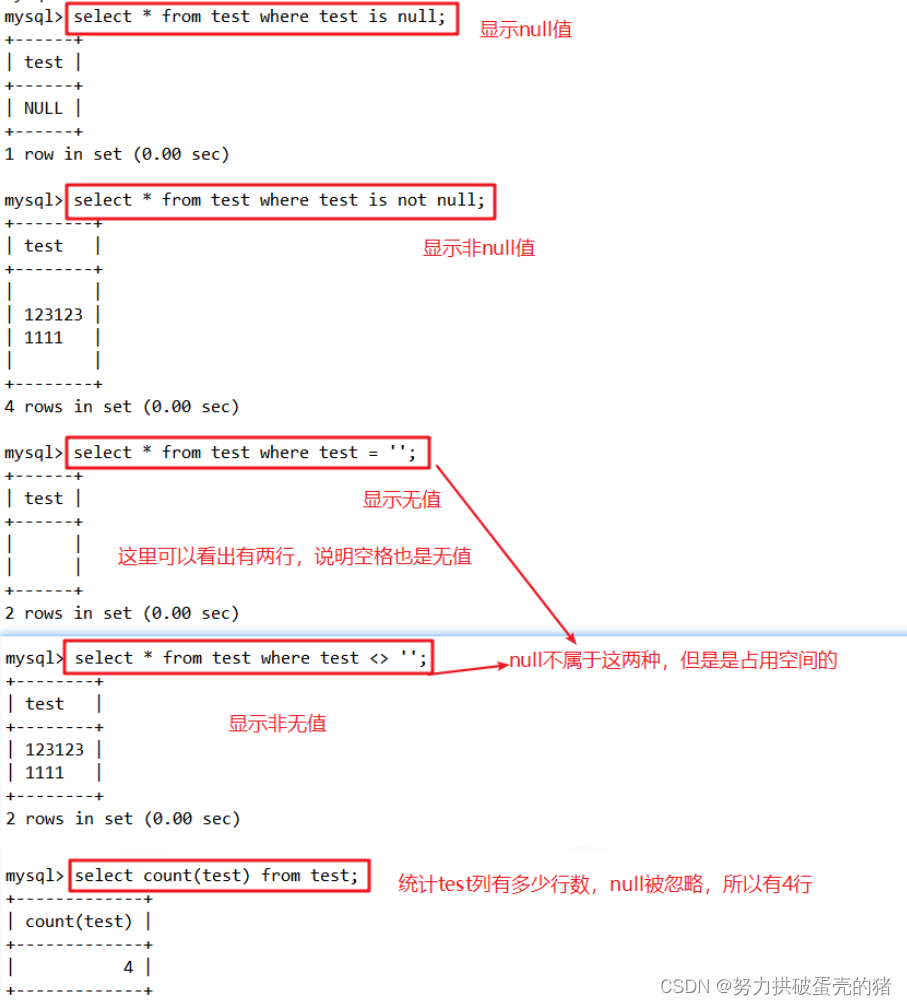
七、MySQL之正则表达式
匹配模式 描述 实例
^ 匹配文本的开始字符 ‘^bd’ 匹配以 bd 开头的字符串
$ 匹配文本的结束字符 ‘qn$’ 匹配以 qn 结尾的字符串
. 匹配任何单个字符 ‘s.t’ 匹配任何 s 和 t 之间有一个字符的字符串
* 匹配零个或多个在它前面的字符 ‘fo*t’ 匹配 t 前面有任意个 o
+ 匹配前面的字符 1 次或多次 ‘hom+’ 匹配以 ho 开头,后面至少一个m 的字符串
字符串 匹配包含指定的字符串 ‘clo’ 匹配含有 clo 的字符串
p1|p2 匹配 p1 或 p2 ‘bg|fg’ 匹配 bg 或者 fg
[...] 匹配字符集合中的任意一个字符 ‘[abc]’ 匹配 a 或者 b 或者 c
[^...] 匹配不在括号中的任何字符 ‘[^ab]’ 匹配不包含 a 或者 b 的字符串
{n} 匹配前面的字符串 n 次 ‘g{2}’ 匹配含有 2 个 g 的字符串
{n,m} 匹配前面的字符串至少 n 次,至多m 次 ‘f{1,3}’ 匹配 f 最少 1 次,最多 3 次
语法格式:
语法:SELECT "字段" FROM "表名" WHERE "字段" REGEXP {模式};
SELECT * FROM Store_Info WHERE Store_Name REGEXP 'os';
SELECT * FROM Store_Info WHERE Store_Name REGEXP '^[A-G]';
SELECT * FROM Store_Info WHERE Store_Name REGEXP 'Ho|Bo';